My parents are verrrry picky eaters who eat primarily home cooked, gourmet Indian food, so I was beyond thrilled when they devoured this vegan dal makhani. And since I’ve gotten so many requests for a vegan dal makhani recipe in the last year, I figured it was about time to share one with you!
This recipe is a labor of love and is not a weeknight, Westernized version of an Indian recipe. That’s because traditional Indian recipes are not quick; they layer so many different spices and flavors, and cooking them together takes time to meld into a harmonious dish that will delight your tastebuds.
So, if you’re looking for authentic, gourmet, restaurant-quality Indian food that will blow your mind, this recipe is a must-make. The flavors are complex and linger on the tongue, and the texture is unctuous, velvety, and luxurious. It’s a whole experience. And an even better one when paired with my homemade vegan naan (it’s fluffy, pillowy, chewy, and buttery!).
If you have an Instant Pot, I highly recommend making the Instant Pot version because it’s much quicker and just as tasty! And you can find several more Indian and Indian-inspired Instant Pot recipes in my cookbook, The Vegan Instant Pot Cookbook.
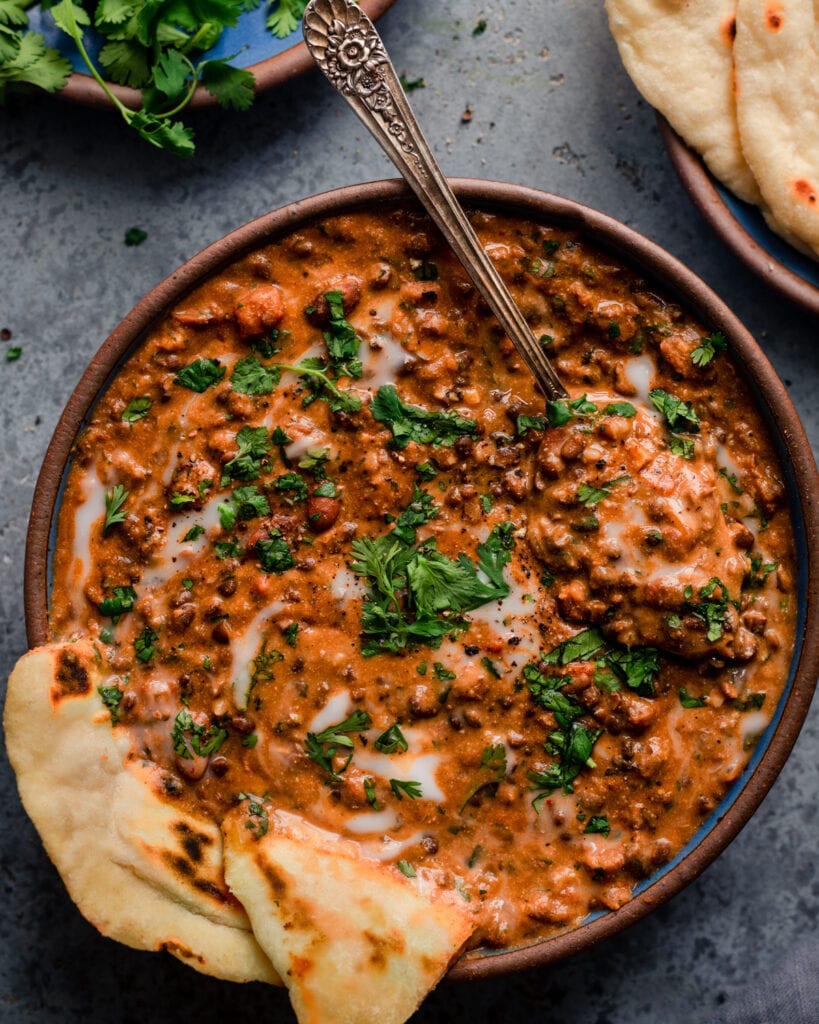
What is Dal Makhani?
In India, dal refers both to the ingredient–pulses, such as lentils, split peas, chickpeas (chana), kidney beans, and more–as well as the dish. If you want to read more about dal and the different pulses used in dal, please read my Restaurant-Style Dal Tadka blog post.
There are everyday dals, the kind I ate most nights as a kid. And then there are dals for fancy times, and Dal Makhani squarely falls into the latter camp. It’s incredibly rich and sumptuous and quite possibly my favorite dal.
Dal Makhani is a North Indian dal that originated in the Punjab region of modern-day India and Pakistan. It was officially “invented” by well-known chef and restaurateur Kundan Lal Gujral in the mid-20th century, but has origins dating further back (read more about the history of Dal Makhani here).
Fun fact: Dal Makhani has the same flavors as the popular “butter chicken” (i.e., murgh makani).
Dal Makhani is made with (1) whole urad dal (also known as black gram). Whole urad dal look like black lentils and are often marketed as such, but they’re not actually lentils. They’re the seeds of a leguminous plant called Vigna mungo, and have a thin black coating and an inner white seed.
Many recipes, including mine, also include a small amount of (2) kidney beans, commonly referred to as rajma.
The pulses (i.e., lentils and beans) are simmered with spices, aromatics, and tomatoes for several hours, or even overnight. The slow simmering is what lends the creamy, viscous texture. It also features a generous amount of butter and cream (makhan = “butter” in Hindi). Traditionally, it’s simmered in a tandoor (clay) oven or in big pots over large wood fires, which lend a slightly smoky flavor.
Keep on reading to learn how to make authentic-style but vegan Dal Makhani at home (including how to achieve that subtle smoky taste without using a tandoor oven!).
Want more gourmet veganized Indian recipes? Don’t skip these!
– Aloo Gobi: Roasted potatoes and cauliflower are coated in a fragrant and flavorful masala.
– Palak “Paneer”: An easy but gourmet plant-based take on palak paneer that’s indulgent but nourishing.
– Tofu Tikka Masala: A creamy and complex spin on chicken tikka masala that’s wow worthy.
– Malai Kofta: Crispy dumplings in a creamy, spiced curry. Perfect celebratory dish!
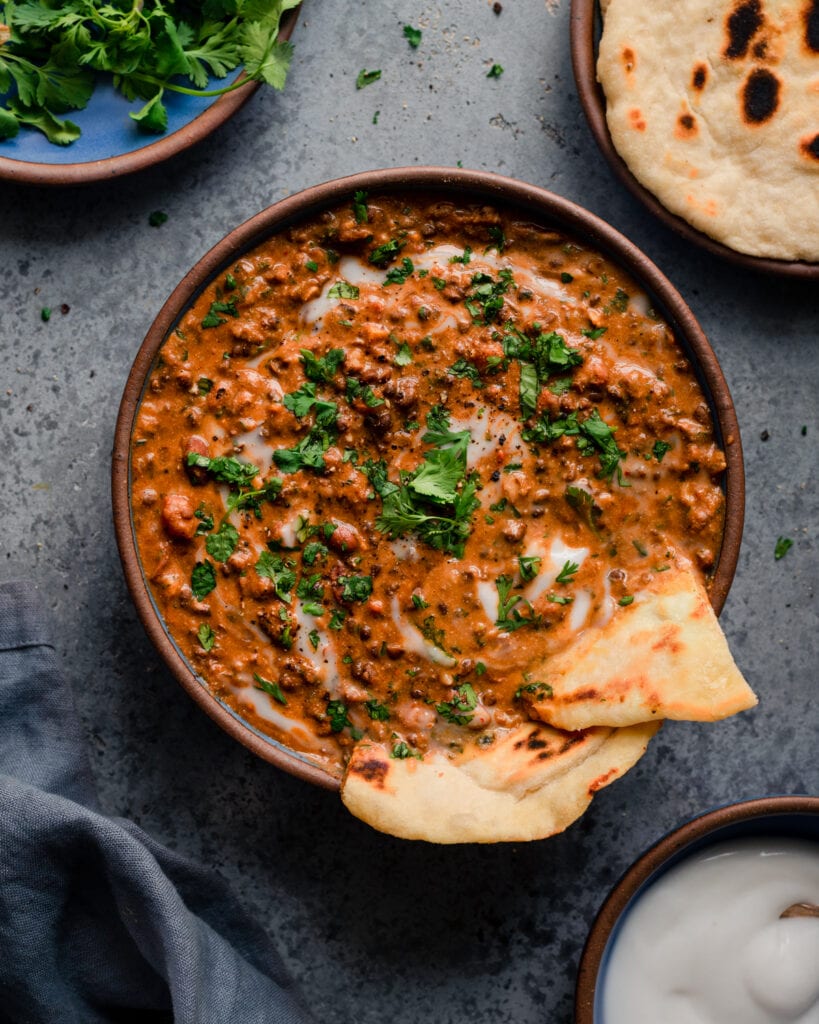
How to make Vegan Dal Makhani
Note: you can find Instant Pot instructions in the recipe card below.
Start by rinsing the dried whole urad dal and kidney beans several times, scrubbing them as you go. This helps remove some of the color from the black “lentils” so the end color of the dal is a nice reddish-brown color, and any debris.
Add to a large bowl, cover with a few inches of water, and add a teaspoon of baking soda. Soak 8 hours, or overnight. Drain the pulses and rinse several times until the water runs clear.
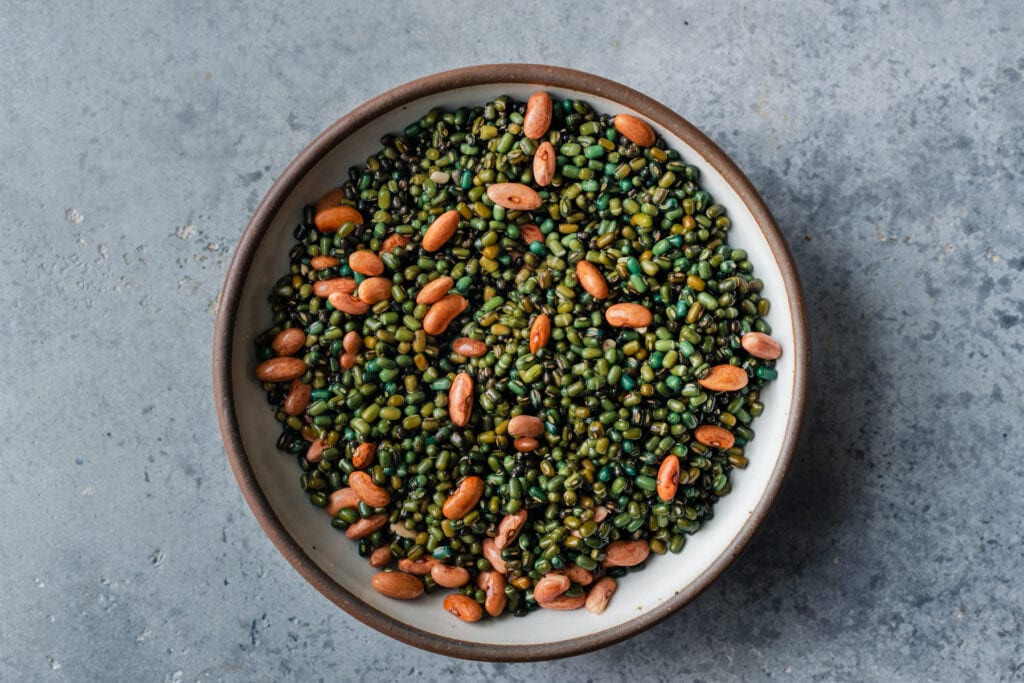
Add the pulses to a saucepan, cover with water, and season with salt. Boil for 10 minutes; reduce heat to a simmer, and simmer for 80 to 90 minutes until both are very soft.
Note: if using the Instant Pot method, you need to soak the beans but you can skip this step of pre-cooking the beans.
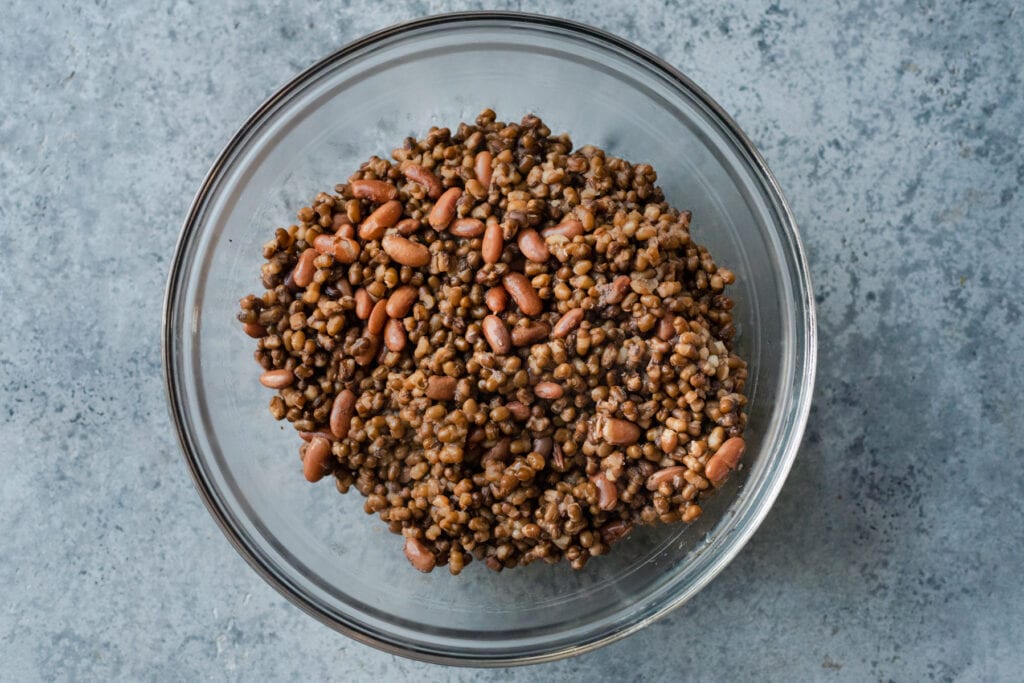
Fit a colander over a bowl and drain the pulses, reserving the cooking liquid. Measure out the cooking liquid and add enough water to make 3 1/2 to 4 cups. Roughly mash the pulses with a potato masher, large wooden spoon, or fork.
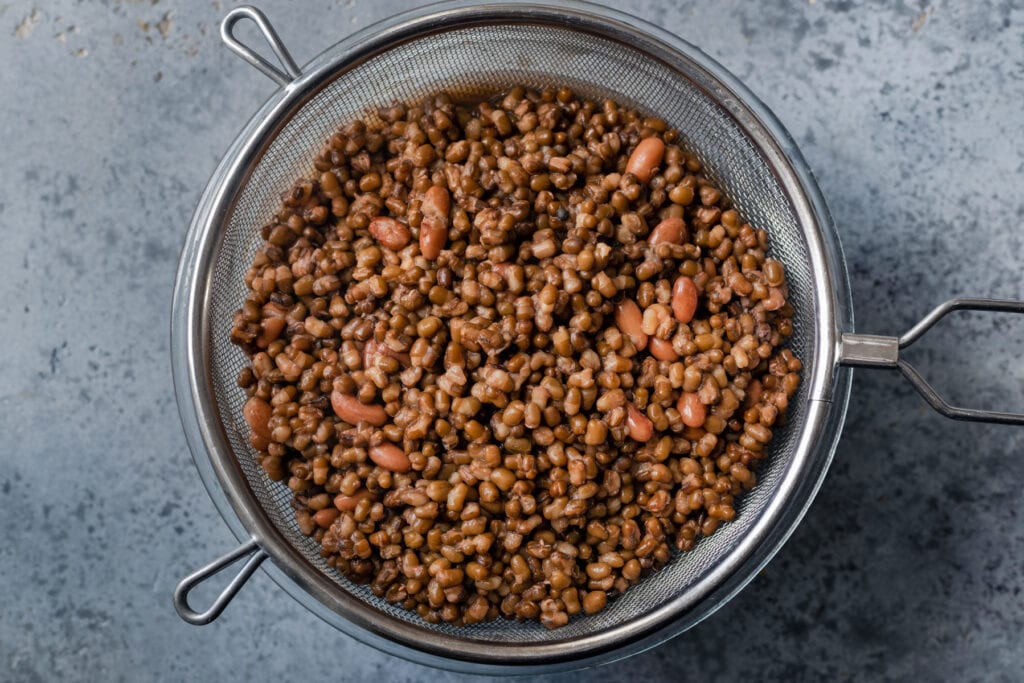
Heat a deep sauté pan over medium-high heat with a bit of oil. Once hot, add the whole spices (cinnamon stick, cloves, cardamom, cumin seeds, bay leaf). Toast briefly until aromatic.
Add the finely diced onion and cook until lightly browned, 5 to 7 minutes.
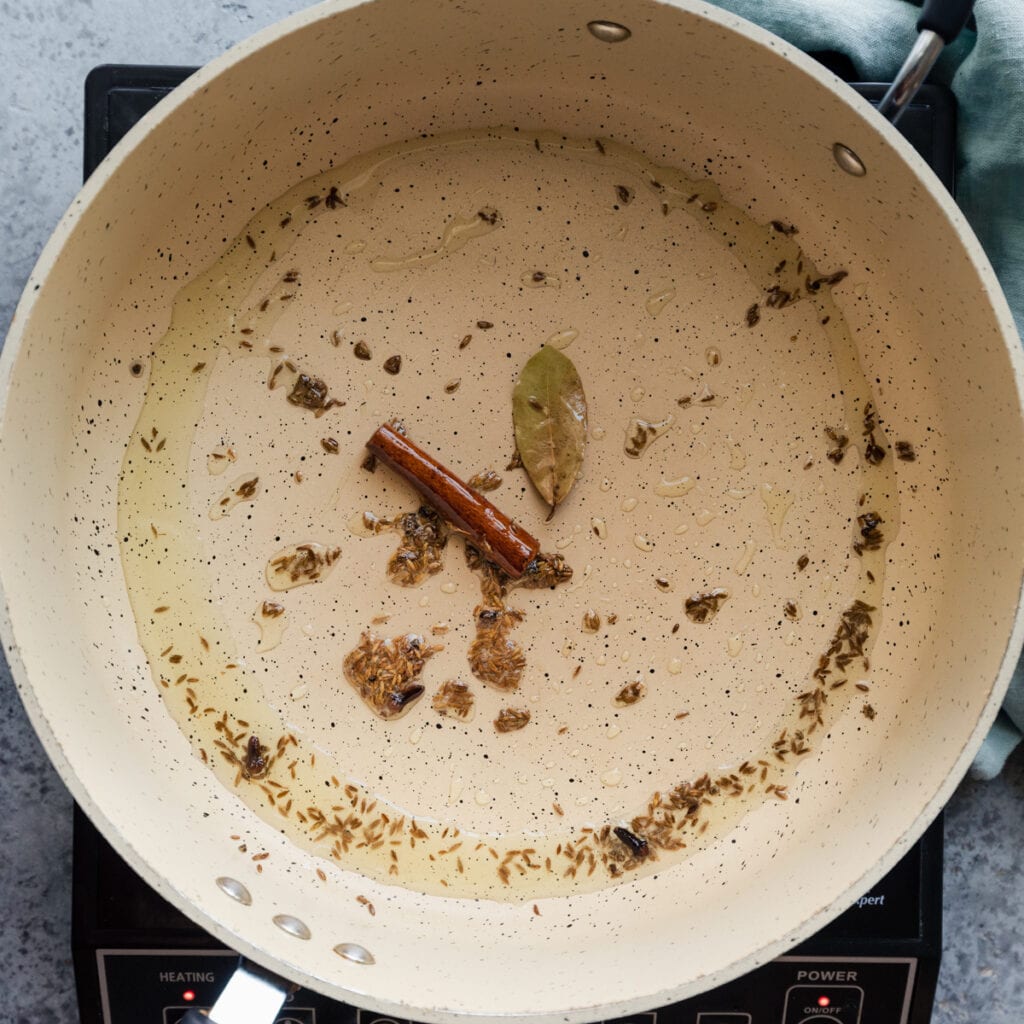
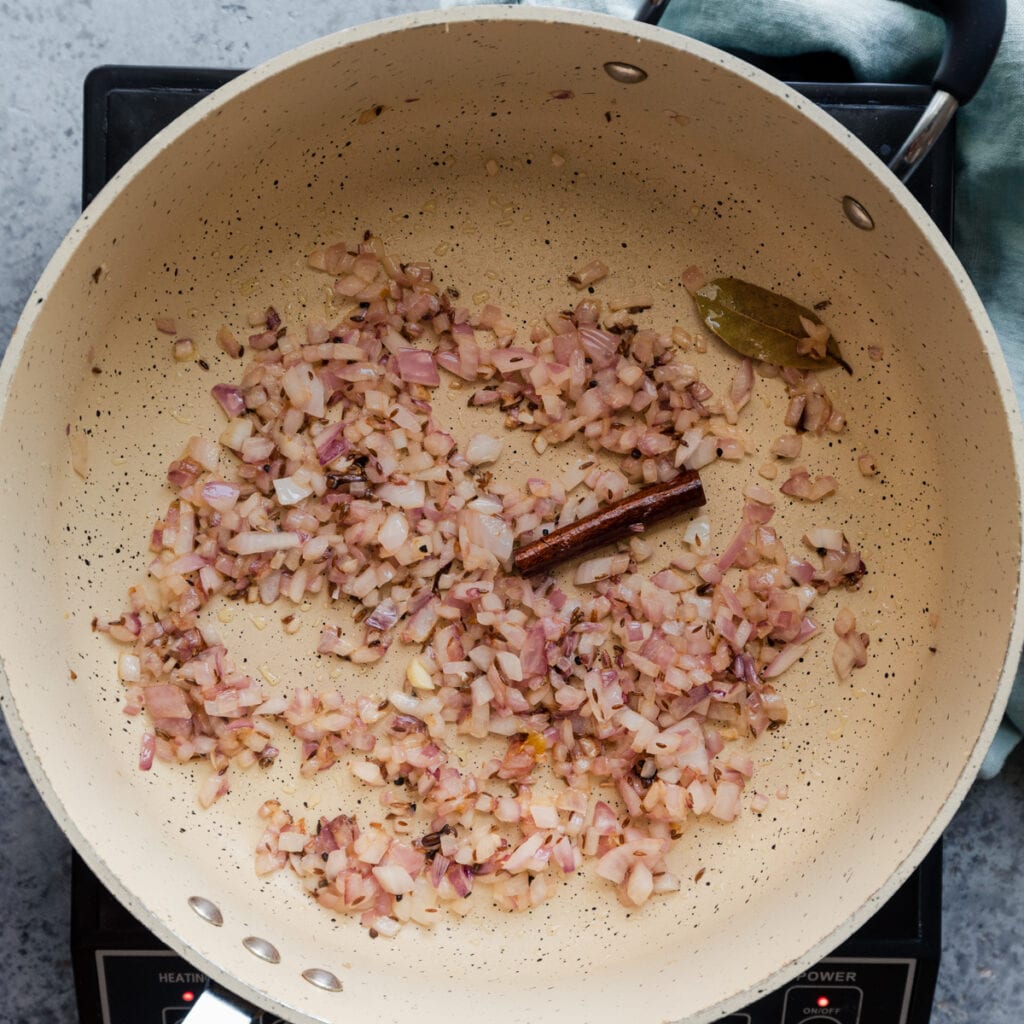
Add the ginger and garlic and cook for 1 minute, stirring frequently.
Stir in the ground spices (coriander, nutmeg, Indian red chile powder), salt, pepper, and tomato paste. Cook down for 60-90 seconds, stirring frequently.
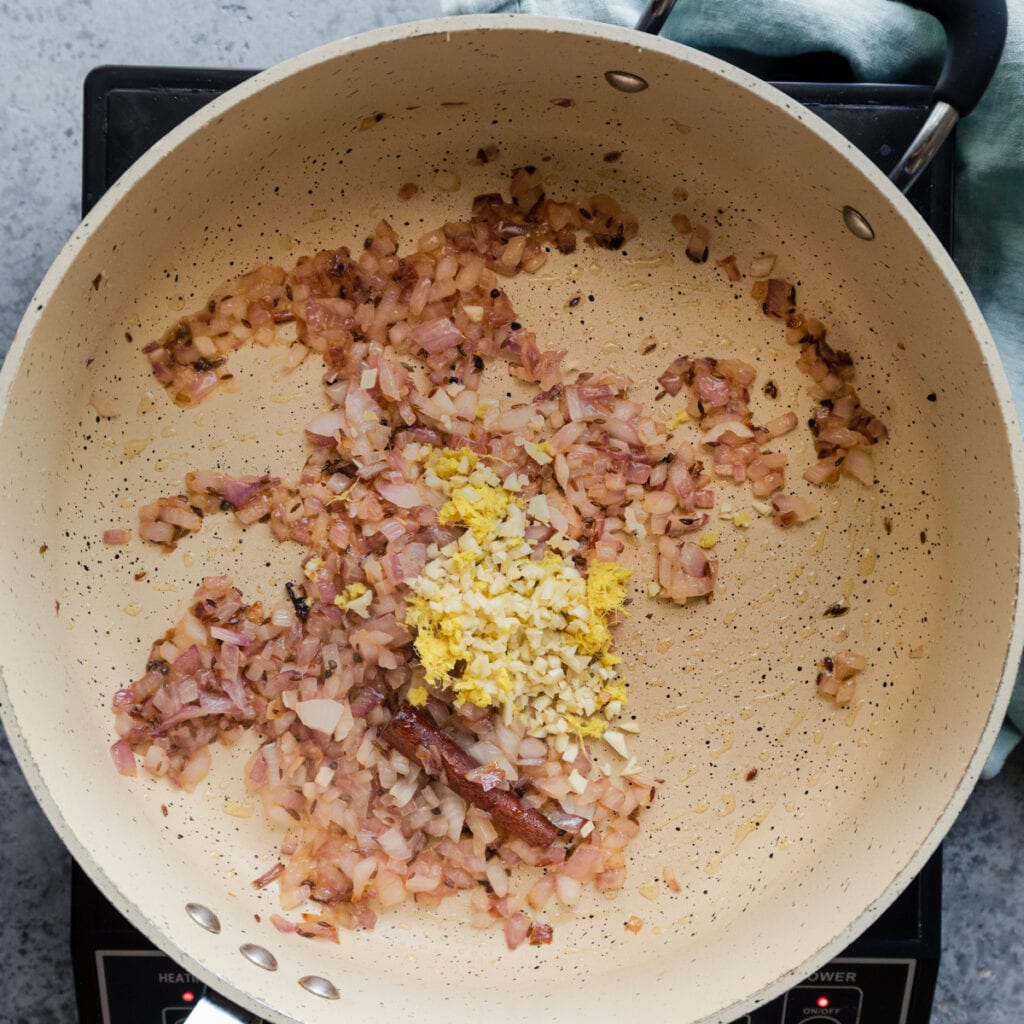
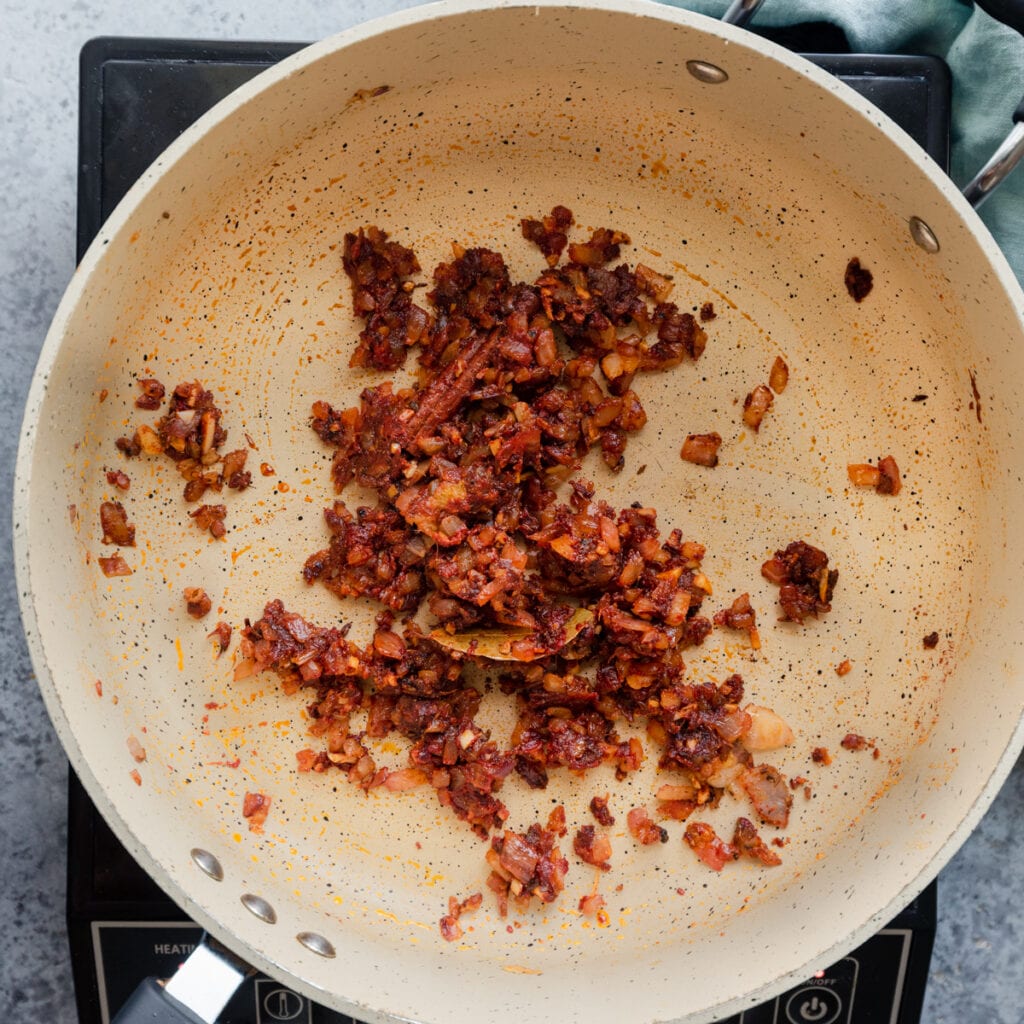
Add the diced tomatoes (and their juices). Cook for 2-3 minutes until softened.
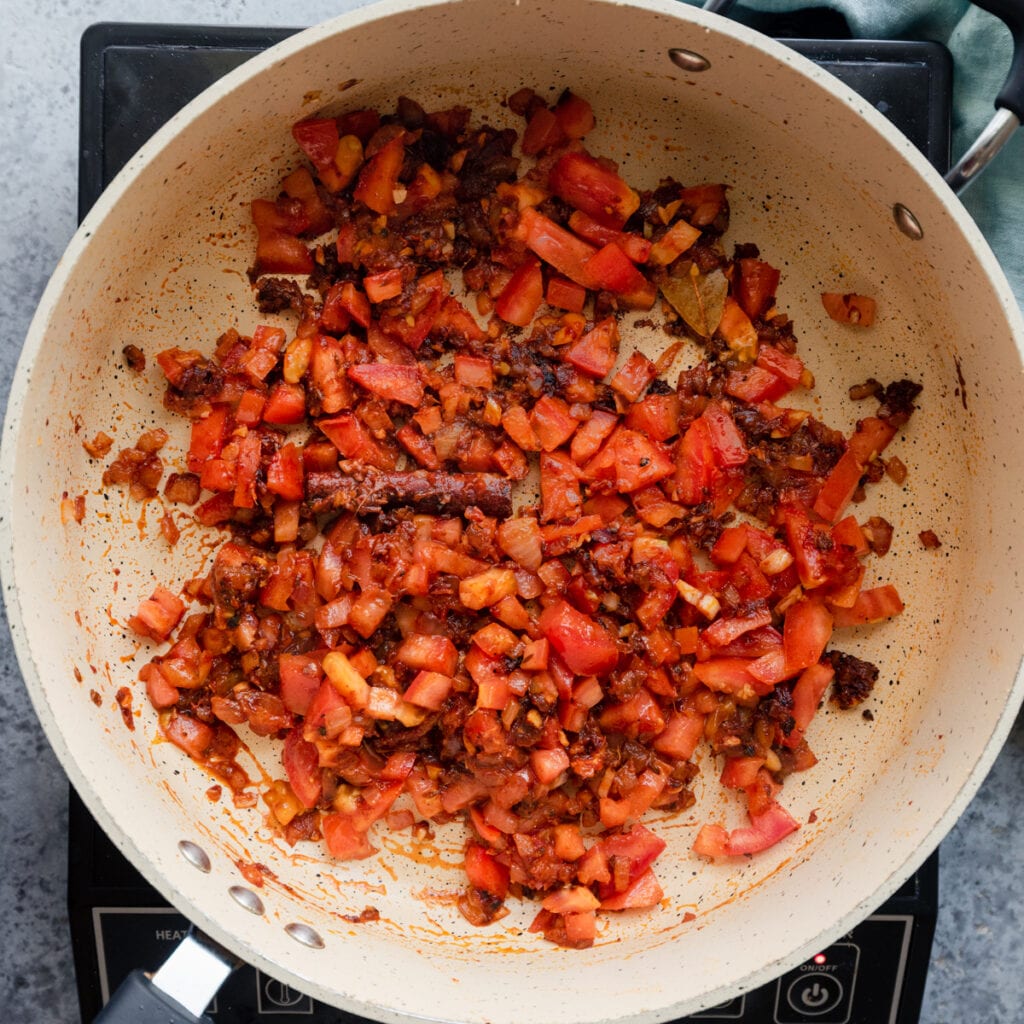
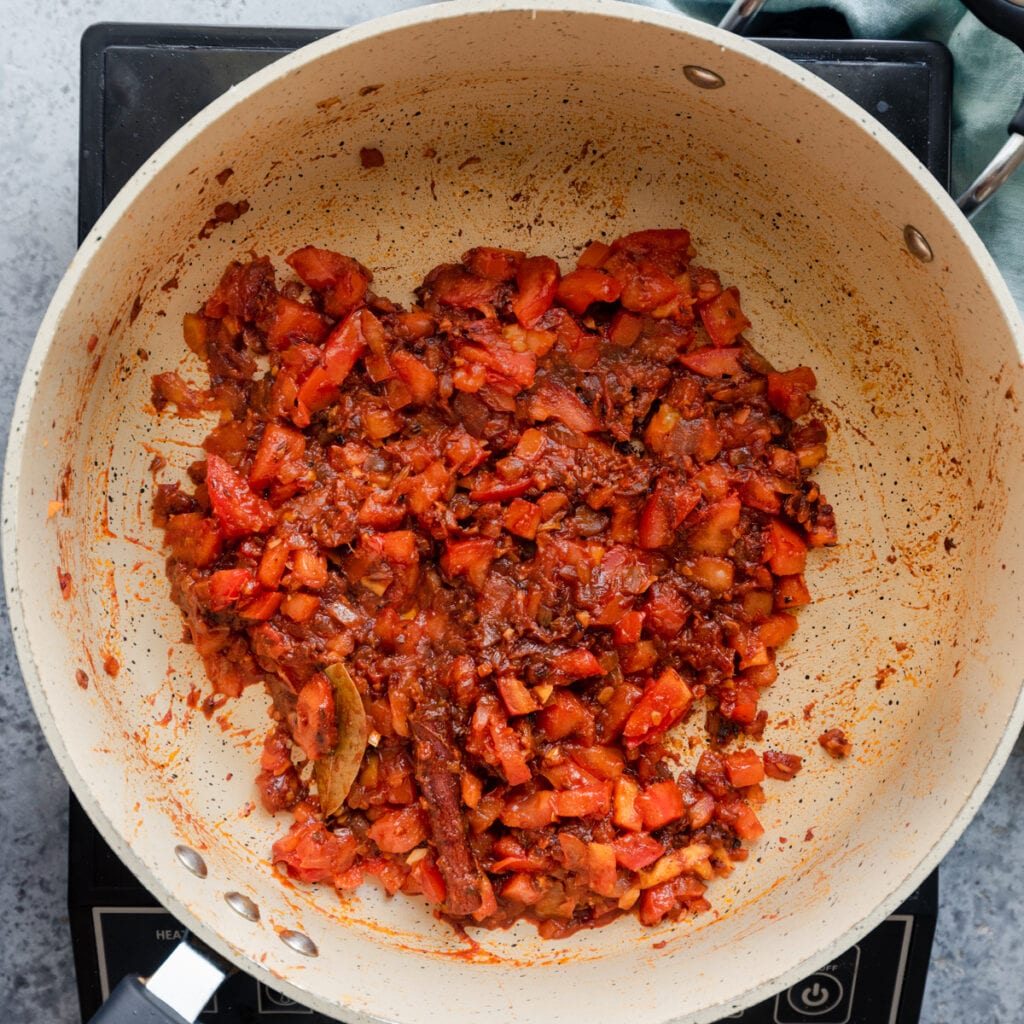
Pour in the bean liquid/water, mashed pulses, and bring the mixture to a boil.
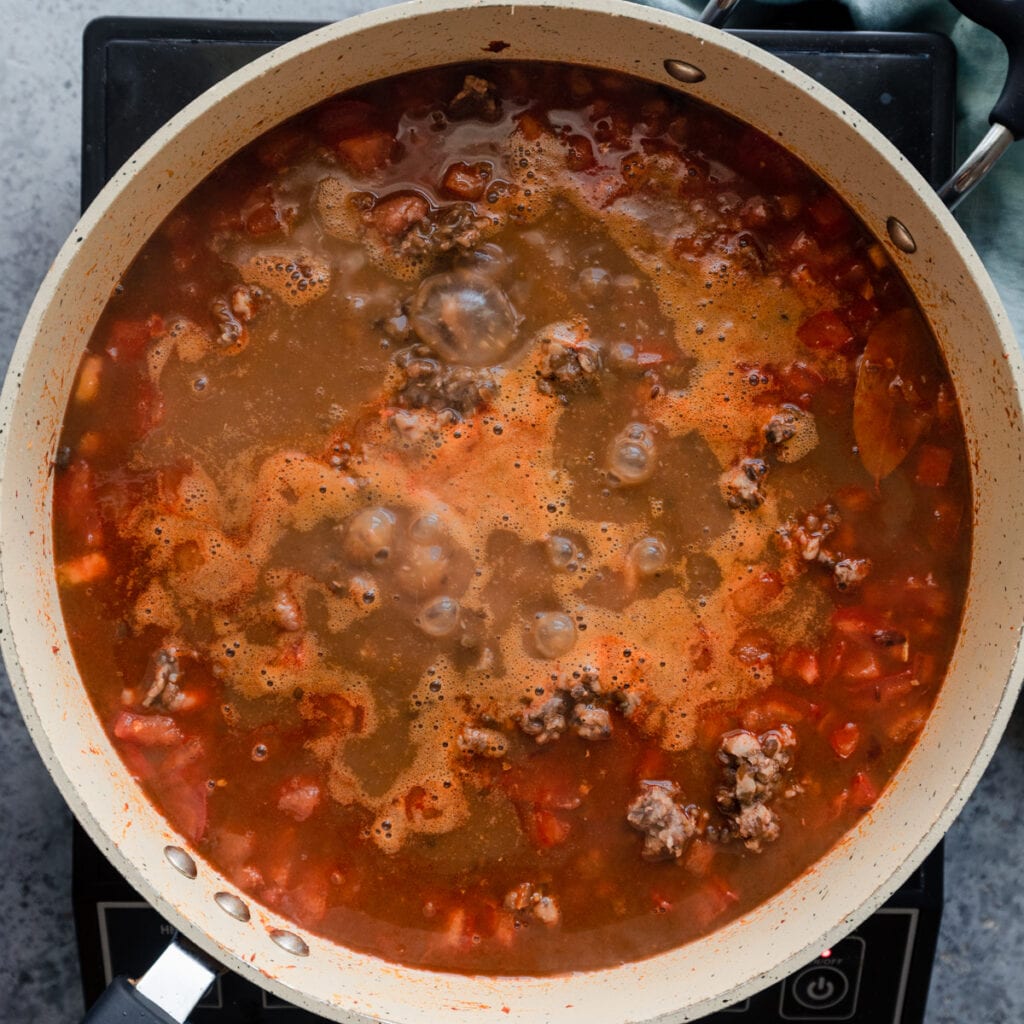
Once boiling, reduce to a gentle simmer and simmer for 70 to 90 minutes, stirring every 10ish minutes. If it starts to dry up, add freshly boiled water from a kettle.
This is what it looked like after 45-50 minutes.
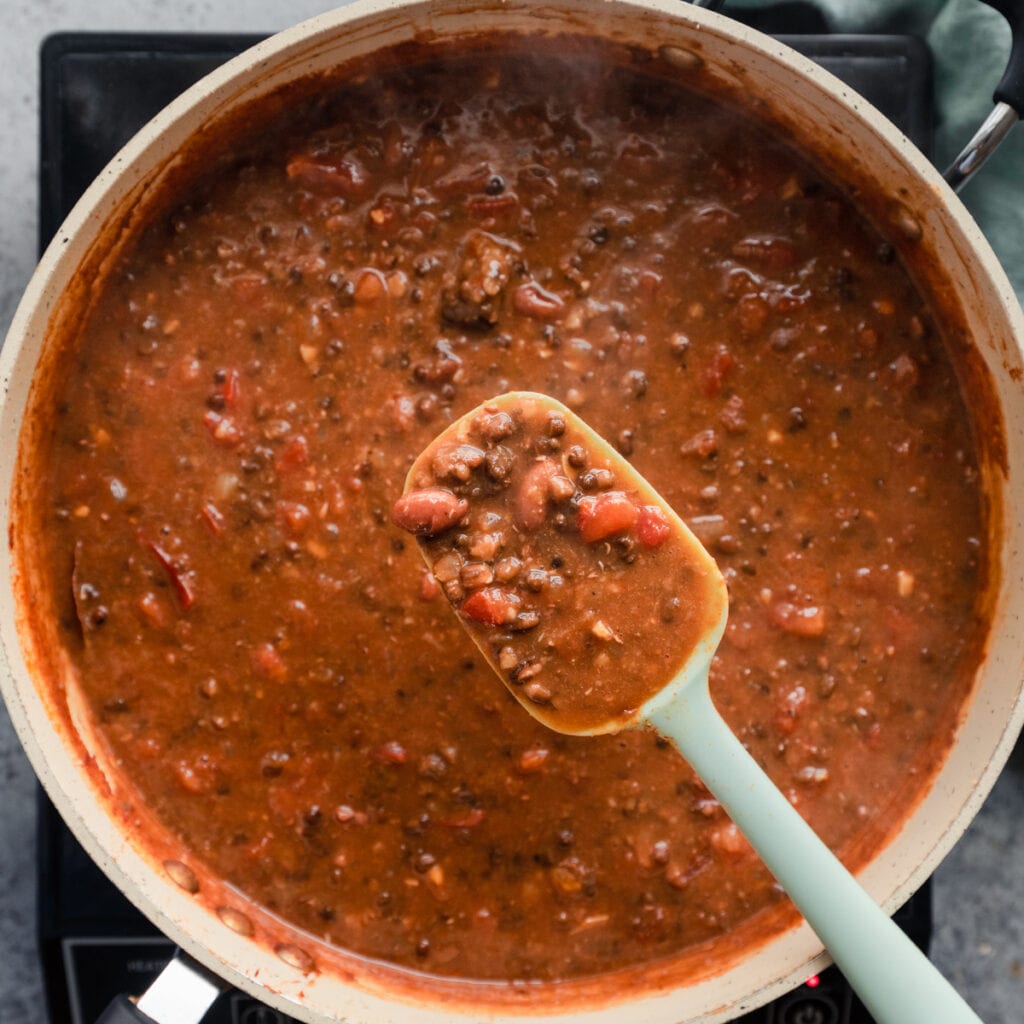
This is what it looked like after 80ish minutes.
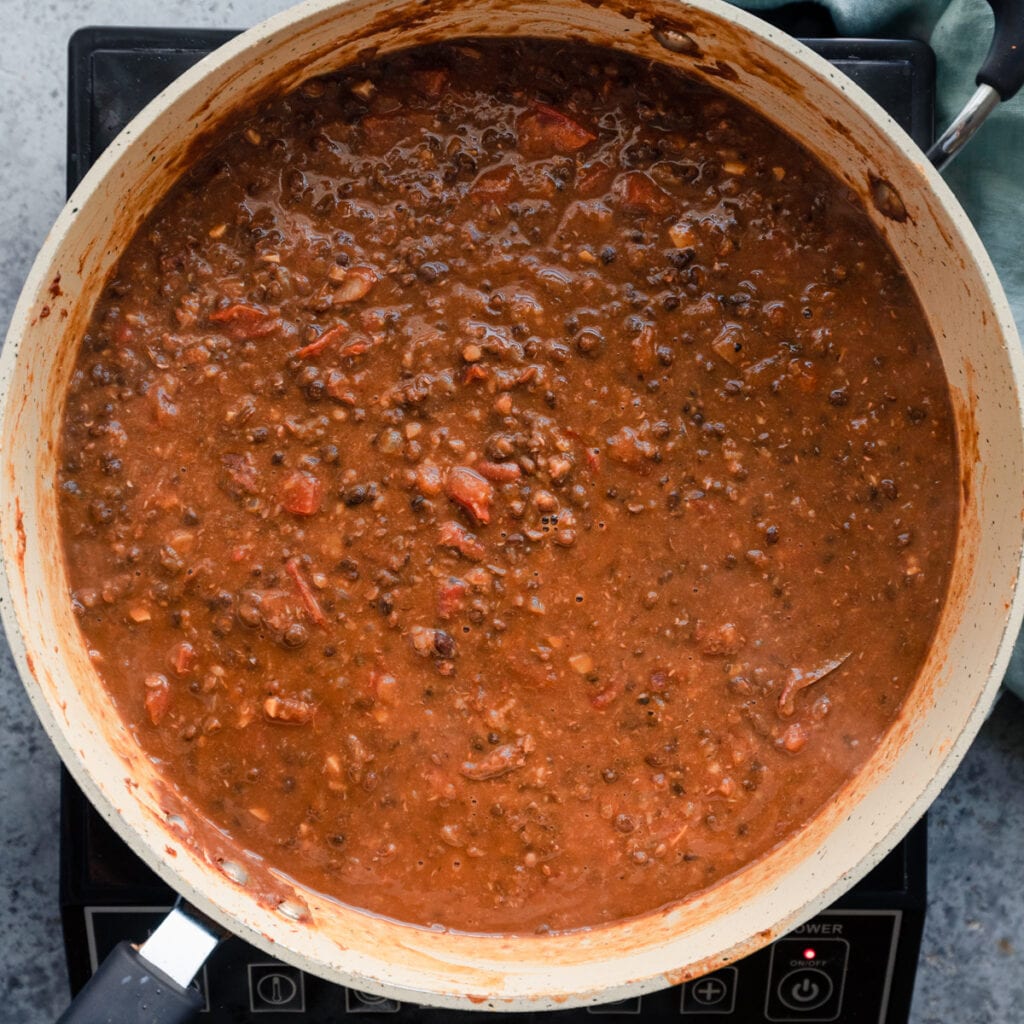
Once the dal is quite thick, add the coconut milk or cashew cream. Simmer for another 10 minutes, stirring once or twice to prevent sticking.
The dal should be very creamy by now. If it’s too thick for your liking, stir in a bit of freshly boiled water.
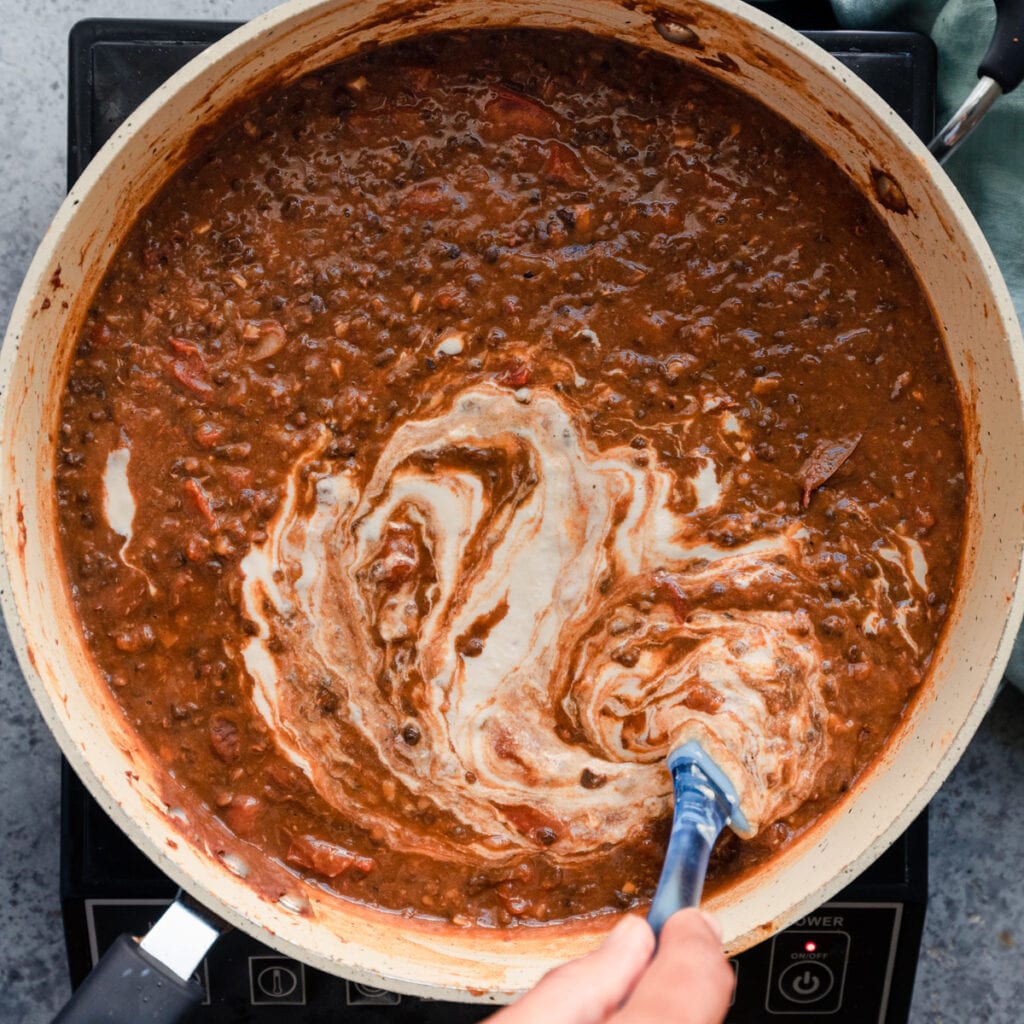
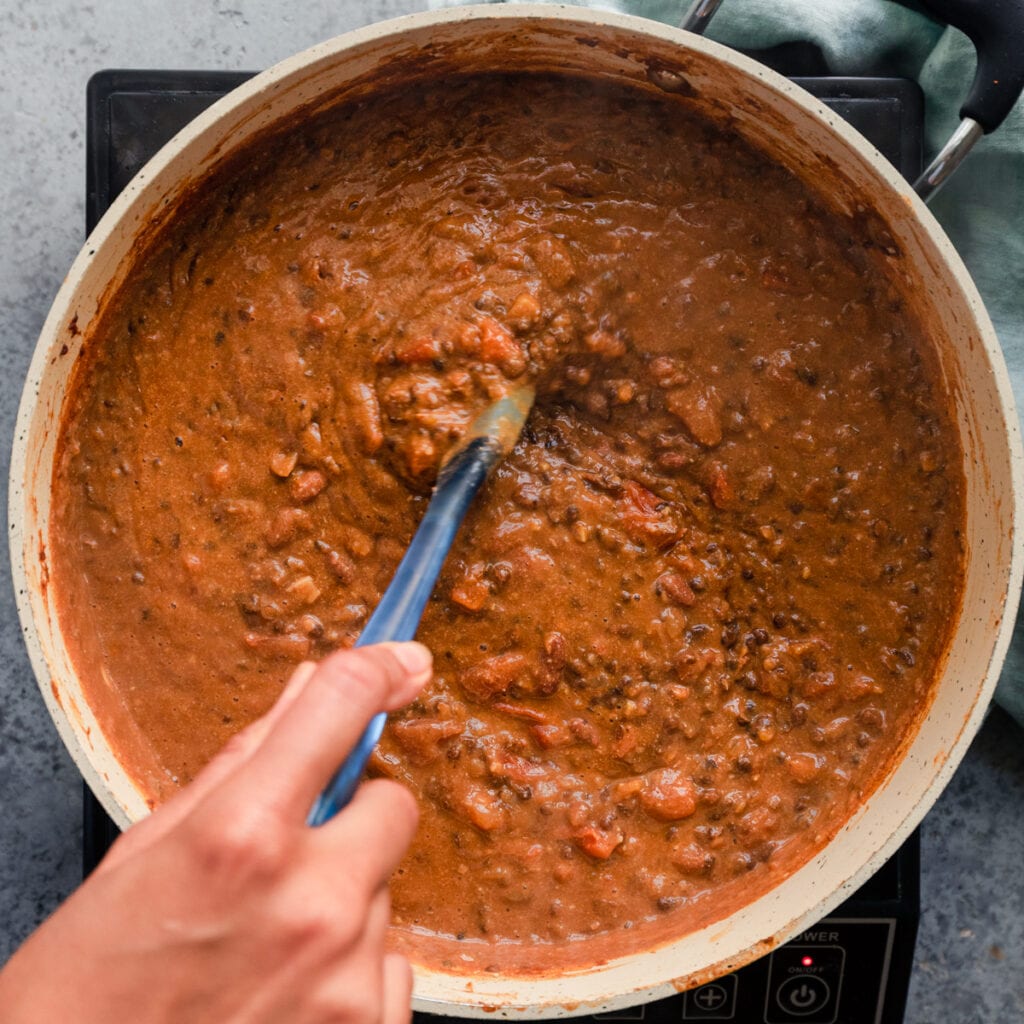
Smoke the dal (optional). See the next section for instructions on the Dhungar method.
Stir in the chopped cilantro and lemon juice, and taste for seasonings, adding salt as needed. Fish out the cinnamon stick and bay leaf.
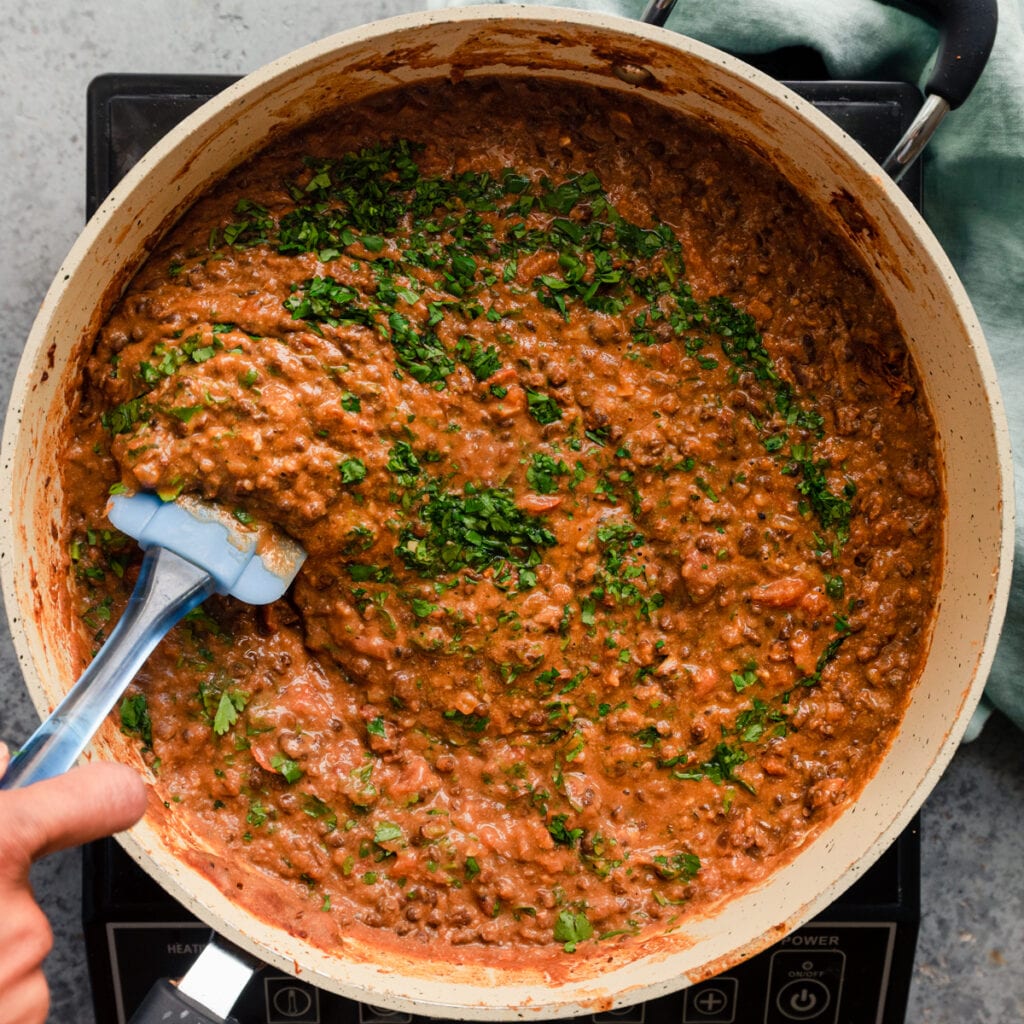
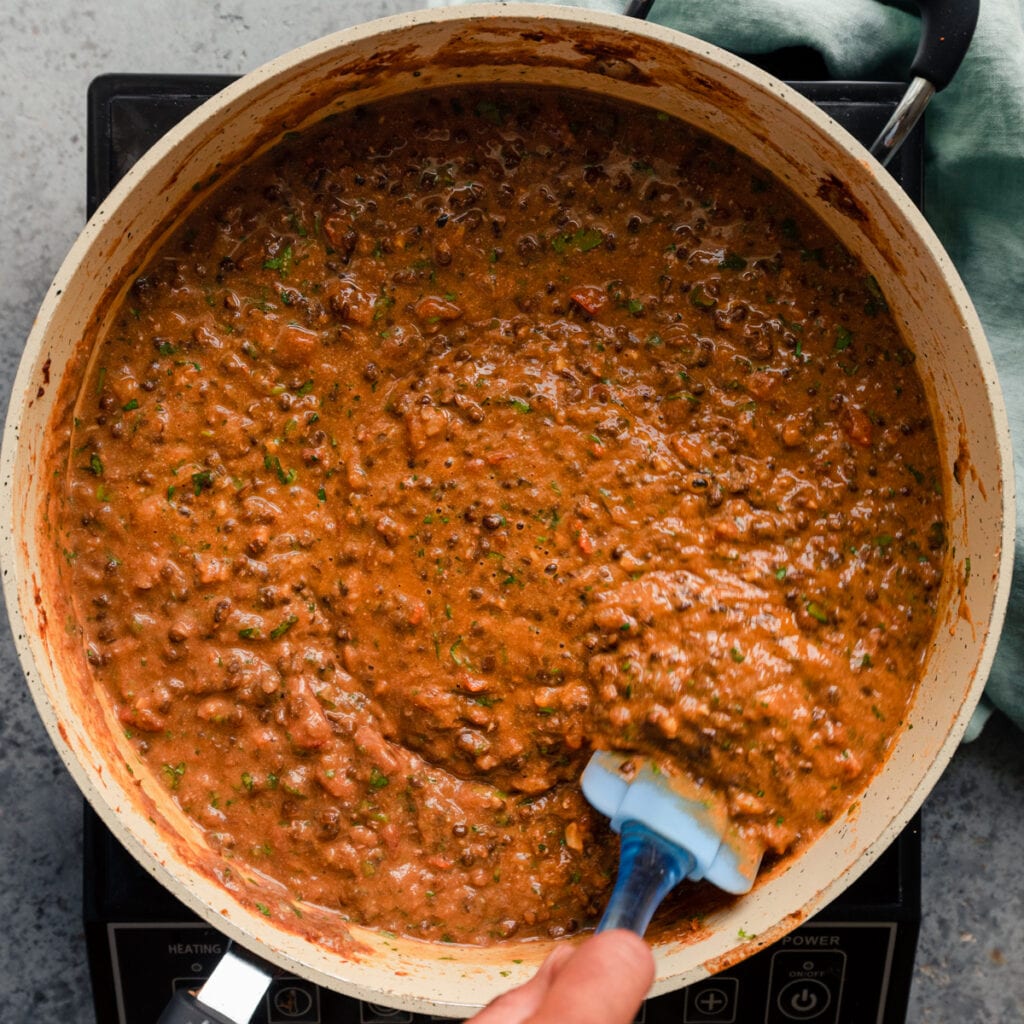
Make the tadka. Heat the vegan butter in a frying pan over medium-high heat.
Once melted and frothy, crush the kasoori methi (i.e., fenugreek leaves) with your hands into the dal, and add the garam masala and Indian red chile powder. Stir and swirl the pan frequently for 30 seconds, then take off the heat.
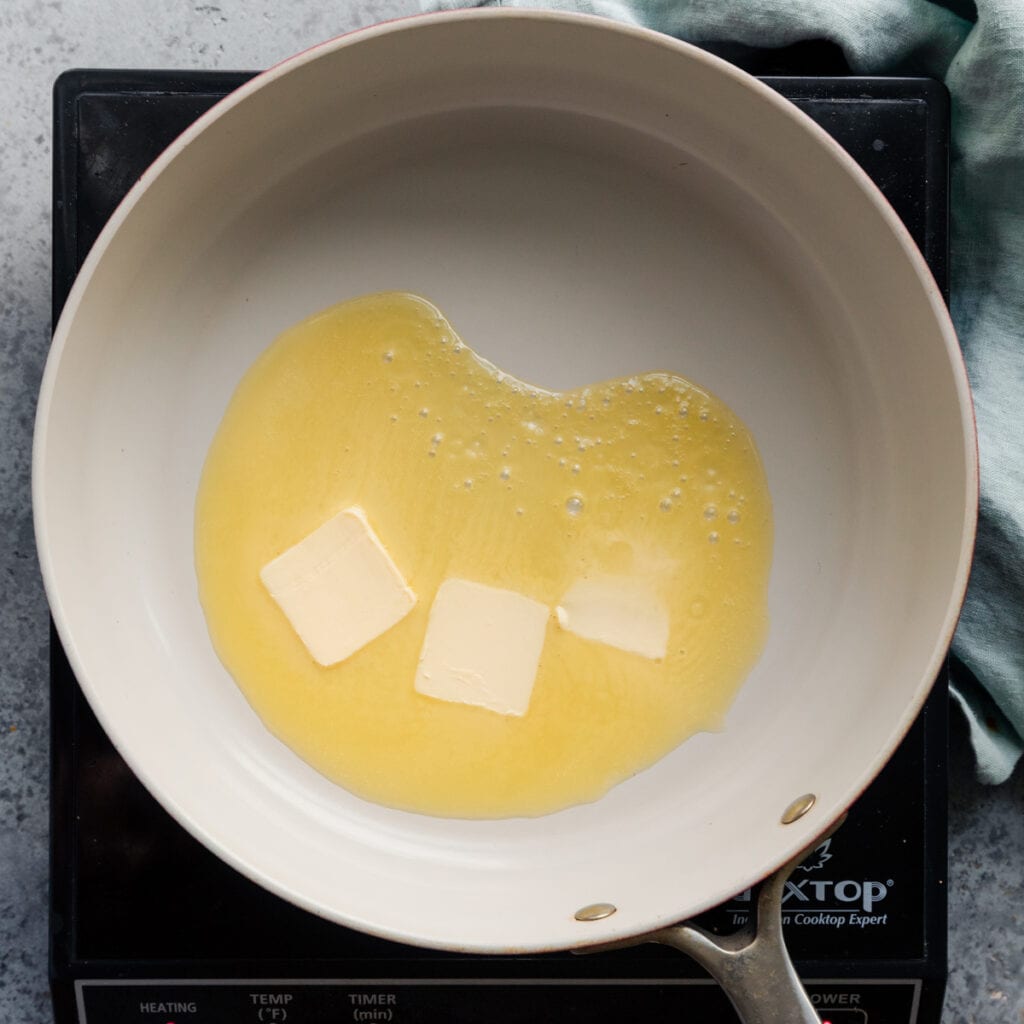
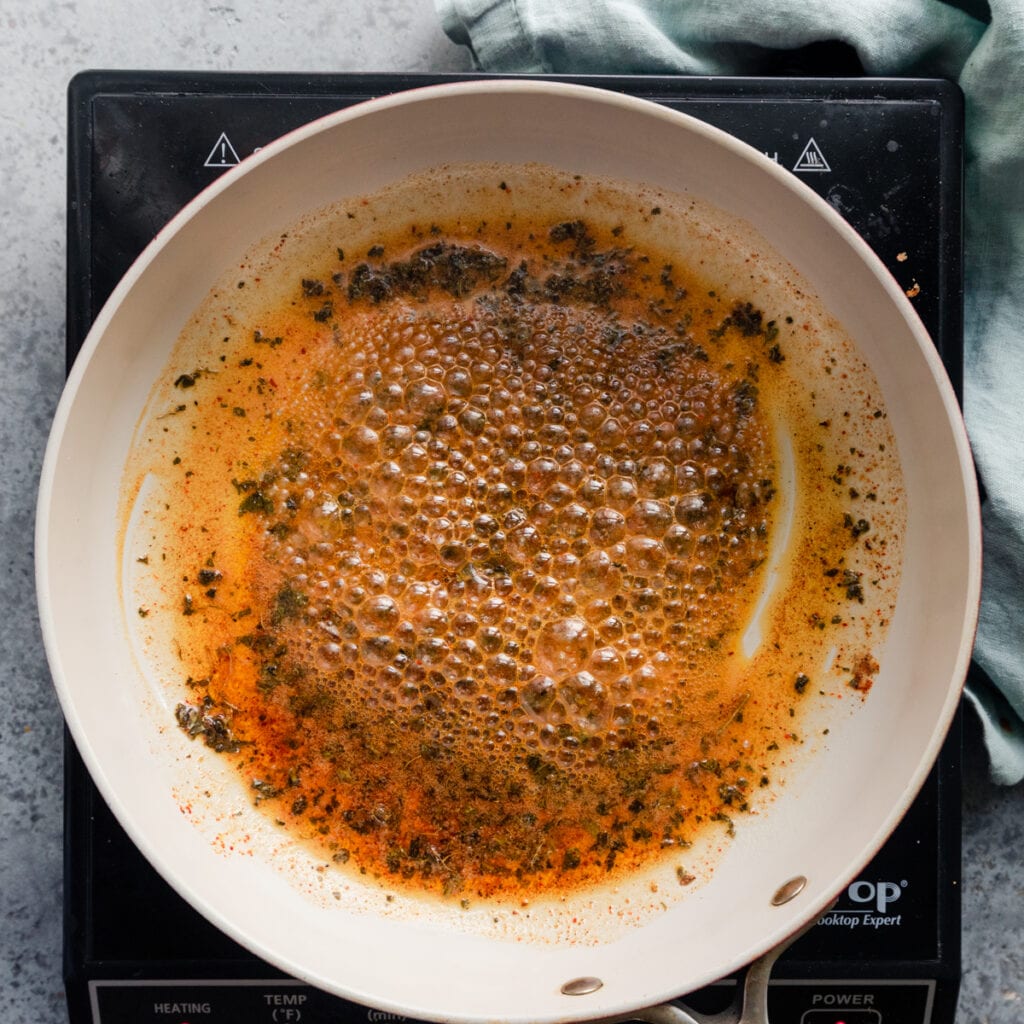
Pour the tadka on top of the dal and stir in.
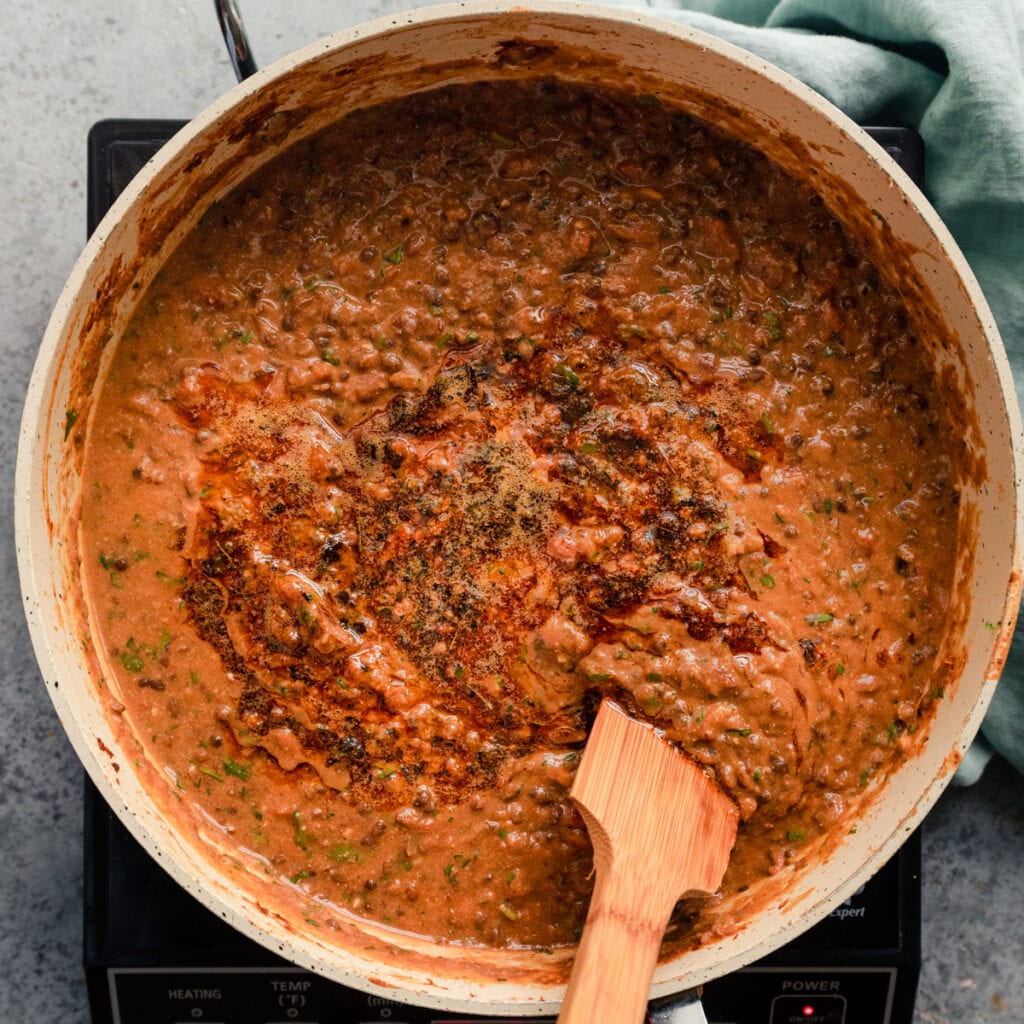
How to infuse a smoky taste into Dal Makhani
Dal Makhani is traditionally cooked in a clay oven or over a wood fire, which brings a smoky taste. To replicate that at home, I use the dhungar method, a South Asian technique of coal smoking food. The smoky flavor is subtle but makes the dal even more irresistible and gives it that je ne sais quoi.
Dhungar method instructions
- Position a small glass or stainless steel bowl in the middle of the cooked dal. If you don’t have either, slice an onion along its orbit and hollow out one half. Use the cavity as your bowl.
- Take a 1- or 2-inch piece of all-natural lump charcoal (you can buy this at many grocery stores and hardware stores). Using tongs, hold the charcoal directly over an open flame (I use my gas burner). Rotate it occasionally and cook for a total of 2 to 3 minutes, until red hot in some spots and a few white markings appear on the charcoal.
- Note: I don’t recommend heating the charcoal for more than 3ish minutes, especially if this is your first time doing this. During one of my many recipe tests, I heated the charcoal for 5 minutes and the smoky taste overpowered the dish.
- Working as quickly as you can, transfer the hot charcoal to the small bowl in the dal and drizzle 1/2 teaspoon of oil onto the charcoal. The charcoal will start smoking immediately (see the below photo). Cover the pan to trap the smoke and let it infuse the dal for 2 to 3 minutes. Discard the charcoal.
For more visual details, please watch the YouTube video (or below) around the 06:00 mark.
If you don’t want to do this step, rest assured, this dal is still very delicious! You can also try adding ½ to 1 teaspoon smoked paprika to the ground spices for a smoky taste.
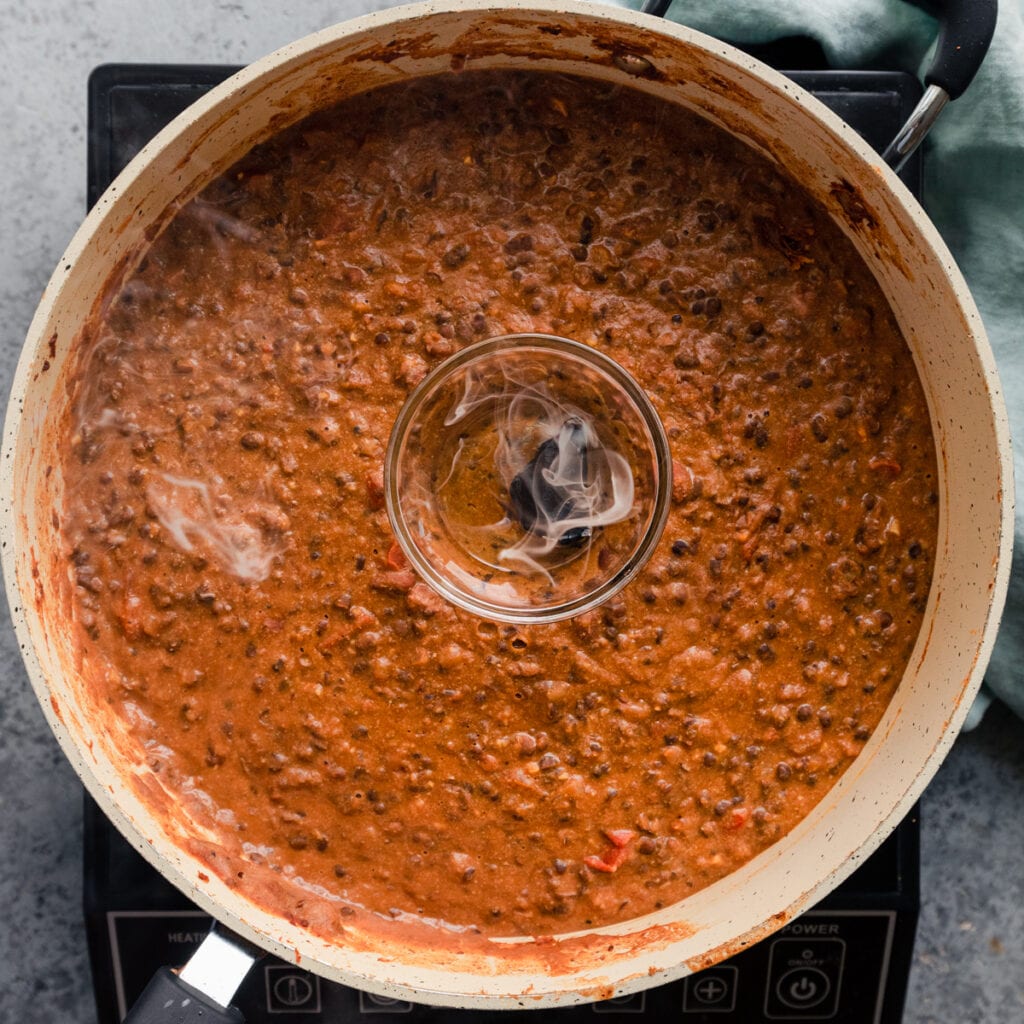
Ingredient Notes and Substitutions
Kidney Beans. If you are cooking the stovetop version and want to speed it up a bit, you can (a) omit the kidney beans and use an additional 1/4 cup of whole urad dal; or (b) use canned kidney beans.
If using canned kidney beans, a few changes: (1) when cooking the whole urad dal, you don’t need to boil it for 10 minutes, and the dal will get soft in a shorter period of time, about 40 to 60 minutes (instead of 80 to 90 minutes); (2) use about 3/4 to 1 cup of canned kidney beaans; (3) roughly mash the beans before adding them to the pot when you add the cooked urad dal and liquid.
Whole urad dal. While these are often referred to as black lentils, they are not lentils and are quite different from the black lentils used in Western cooking (e.g., black beluga lentils). When cooked, black beluga lentils do not get creamy, and therefore aren’t the best option for this sumptuous dal.
If you have a South Asian grocery store in your area, I encourage you to visit it and buy whole urad dal (and lots of spices!). You’ll be supporting what is most likely a family-run small business, the prices are much better than at Western grocery stores, and you’ll be able to enjoy this dish as it’s meant to be.
That said, if you really want to make this dish but don’t have a South Asian grocery store nearby and don’t want to purchase them online, you can substitute a different lentil, like black beluga or green/brown lentils. Again, they don’t soften in the same way, so you’ll get a less creamy result. To rectify some of that, you might want to use less liquid.
PS: you’re looking for whole urad dal (split urad dal is white and smaller).
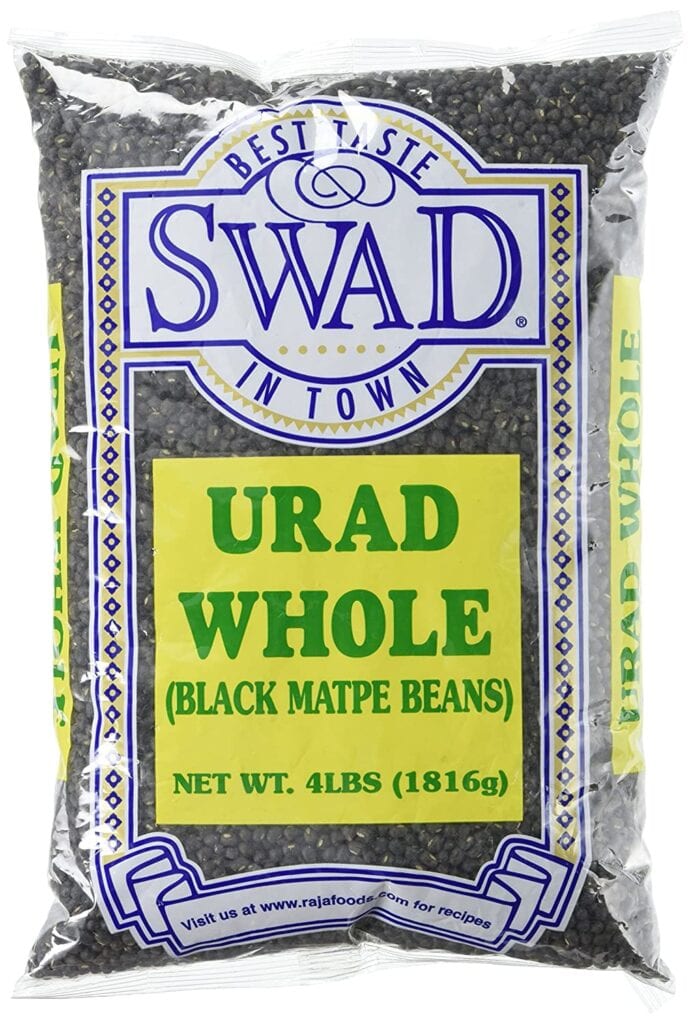
Whole Urad Dal
Also known as black gram. An essential ingredient in Dal Makhani.
Cashew cream vs. coconut milk. Since Dal Makhani typically has cream, the best vegan substitutes are cashew cream and full-fat canned coconut milk (you don’t need much, just 1/2 cup), from a fat content and a creaminess content. I’ve tried this recipe with both and it’s really tasty either way.
I do particularly love it with cashew cream. The neutral yet nutty flavor of cashews works so well with the Indian spices and lentils (cashews are fairly common in Indian cuisine), and the creamy texture is even better than coconut milk.
Of course, making cashew cream requires you to get a blender dirty and soak some cashews (or least boil them for 15 minutes). Since this dish is requires a long simmer time, I just make the cashew cream during the simmering. But, if you want to do less work, use the coconut milk.
Vegan butter. Again, traditional Dal Makhani is known for its butter, so I use a few tablespoons of vegan butter. If you prefer to not use vegan butter, you can sub a neutral-flavored oil (though you won’t have the exact same rich, buttery mouthfeel).
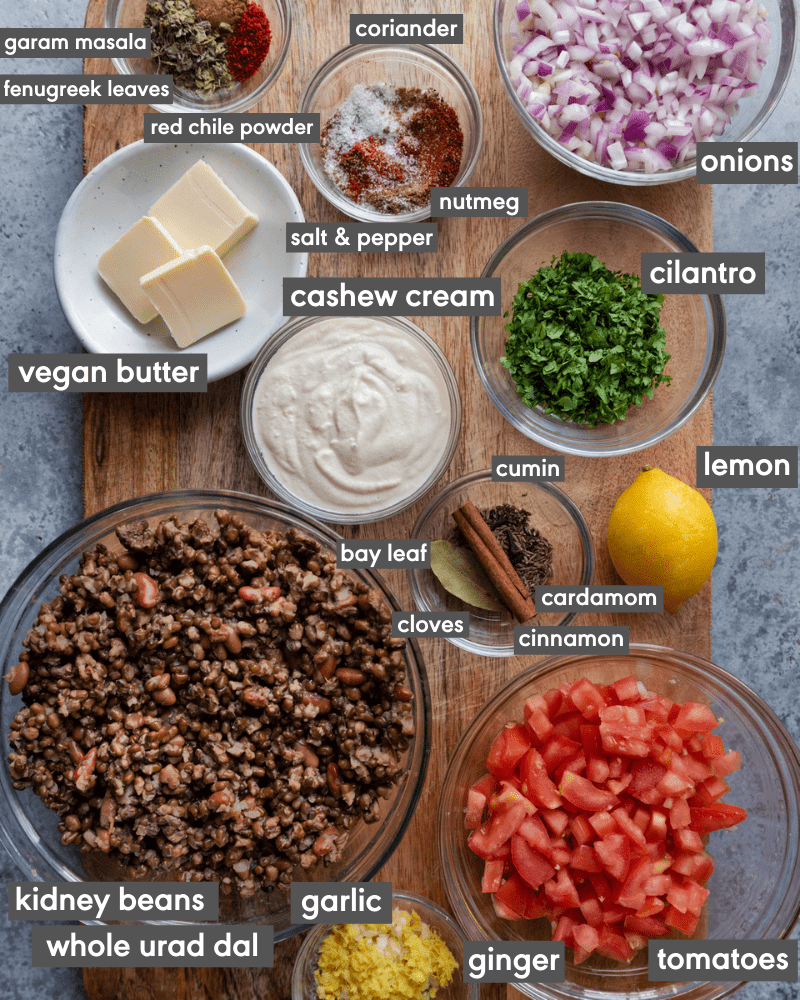
Tips for making Vegan Dal Makhani
Be patient, or use your Instant Pot. As mentioned, slow simmering is what yields that unctuous, luscious texture, so this dish can’t be rushed (at least on the stovetop).
If you want to make this recipe much more quickly, use the Instant Pot method. You don’t need to pre-cook the pulses, the pressure cook time is 35 minutes, and it’s hands off, so you don’t have to stir ever so often. And the results are remarkably similar in texture and taste.
If making the stovetop method and you don’t want to cook everything all in one day, you can pre-cook the beans and lentils 1 to 2 days in advance.
When pre-cooking the dried kidney beans, be sure to let them boil (not just simmer) for the first 10 minutes. Kidney beans contain lectin, a protein that’s hard to break down in digestion. If kidney beans are eaten undercooked, they can cause you to get quite sick.
When pre-cooking the whole urad dal and kidney beans on the stove, if the water starts to evaporate quite a bit, add freshly boiled water from a kettle to keep them covered. If you leave the pot for 90 minutes and don’t check on it at all (like I did a few weeks ago), the beans and lentils will burn and will be unusable. Same thing for the dal makhani itself – if it starts to dry out, stir in some freshly boiled water.
When making the stovetop version, I find that it’s necessary to de-seed the whole cardamom pods. Otherwise, you might get one big concentrated taste of cardamom in a single bit, or chew on a pod. If making the Instant Pot version, just keep the pods whole (the high pressure will disintegrate and evenly mix them).
This dal gets really creamy, but if you want it to be even thicker, use an immersion blender through a third or a half of the dal after adding the cashew cream/coconut milk.
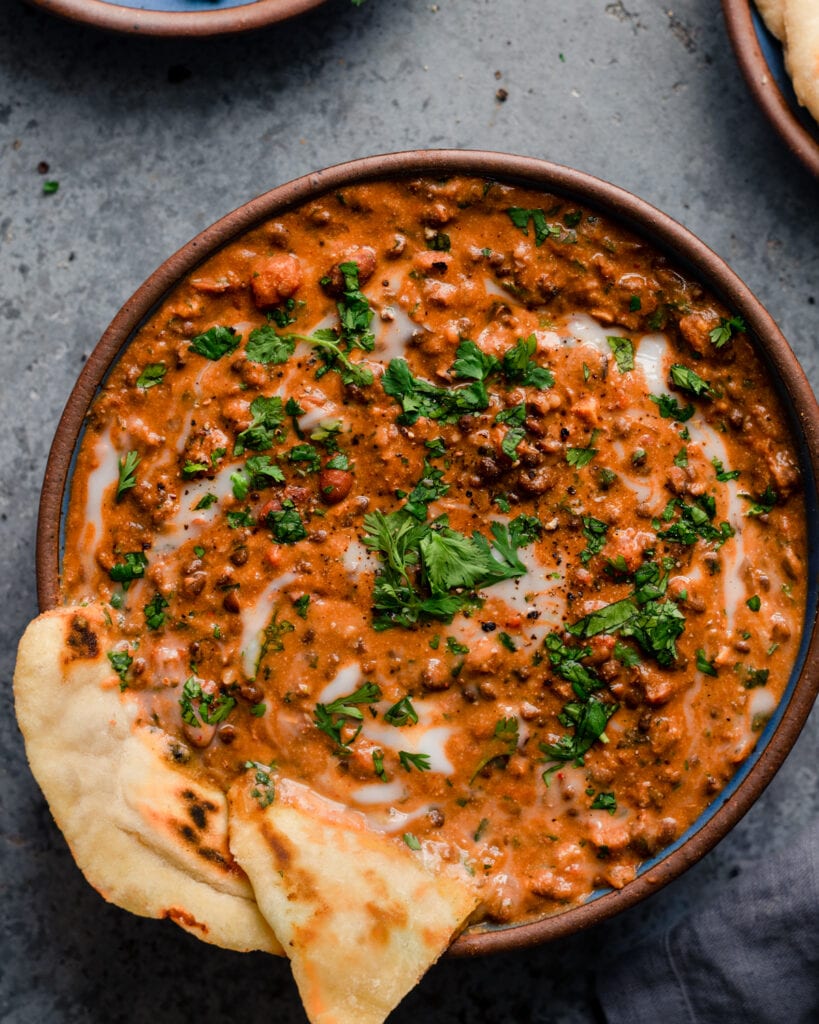
Frequently Asked Questions
With rice or an Indian flatbread (or a combination of both, if you really love carbs like I do lol). I always serve my dals with basmati white rice, but you could do brown rice for a nutrition boost.
As for Indian flatbread, my vegan naan is an epic pairing. For something quicker, you can find vegan naan at Whole Foods, Sprouts, and Trader Joe’s. They’re certainly not as good as homemade, but if you lightly char them over an open flame and brush them with the vegan garlic butter in my homemade naan recipe, it’ll make them a lot better.
This dal will stay good in the fridge for 3 to 5 days.
Yes! I like to freeze in smaller portion so they defrost more quickly.
If you are making this ahead of time, just make the dal and freeze as it – don’t add the tadka at the end. Instead, when ready to serve, make the tadka fresh.
To reheat, you can pop it in the microwave, or heat over medium heat on the stove. If it thickens quite a bit, just add a bit of water while heating.
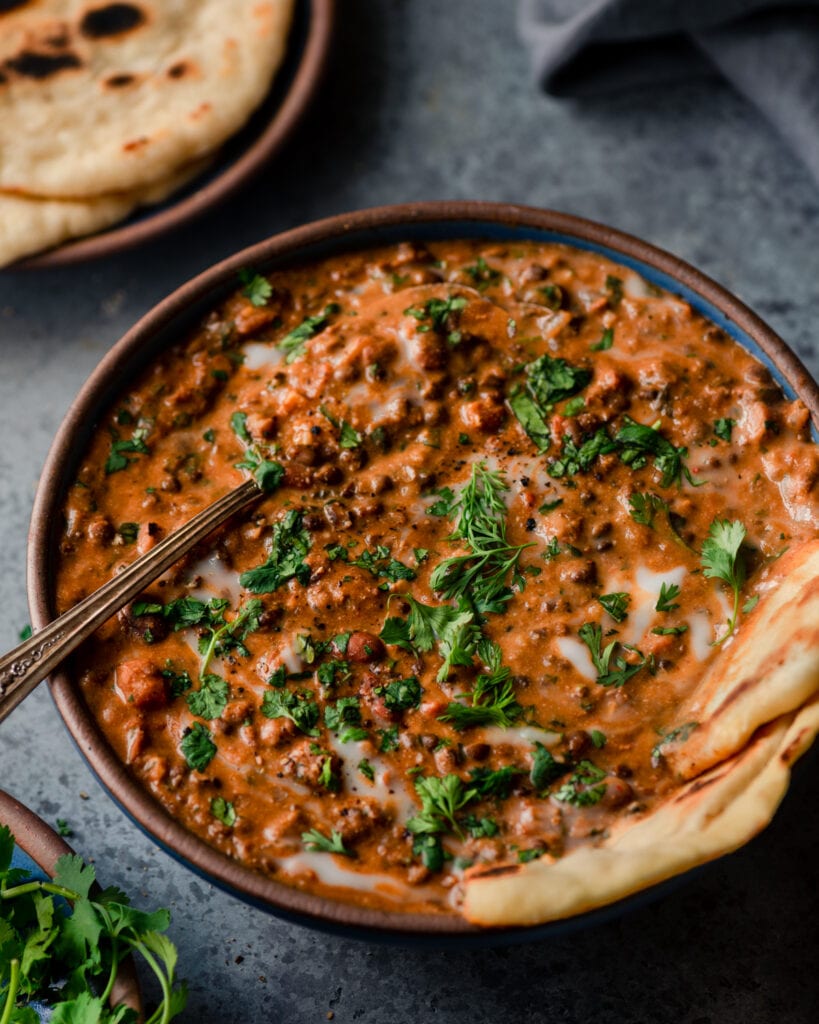
Watch! How to make Dal Makhani
If you try this epic vegan Dal Makhani recipe and love it, please be sure to rate and review it below!
Vegan Dal Makhani
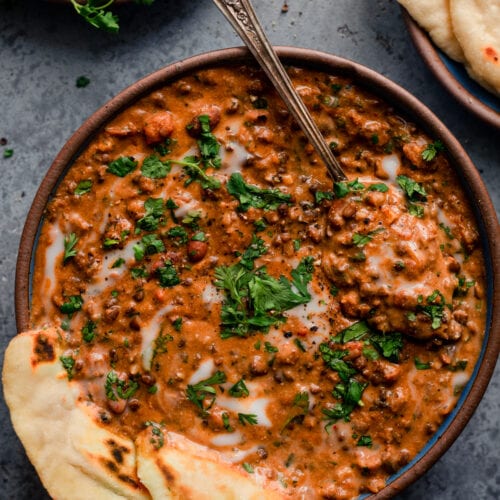
Ingredients
- 1 cup (205g) whole urad dal (aka black gram)*
- ¼ cup (44g) dried kidney beans**
- 1 teaspoon baking soda
Whole Spices
- 1 ½ tablespoons grapeseed oil or neutral oil
- 1 2 to 3-inch cinnamon stick
- 4 green cardamom pods, seeds only (¼ heaping tsp of seeds)
- 3 whole cloves
- 1 bay leaf
- 1 teaspoon cumin seeds
Aromatics and Ground Spices
- 1 medium-large red onion, very finely diced
- 1-inch piece fresh ginger, minced or grated
- 4 garlic cloves, finely chopped
- 2 tablespoons tomato paste
- ⅛ teaspoon nutmeg (I prefer freshly grated, but ground is fine)
- 1 teaspoon coriander
- ½ teaspoon Indian red chile powder**** (1 tsp for a spicier version; 1/4 tps for a mild version)
- 2 teaspoons kosher salt*****
- Freshly cracked black pepper
- 2 medium tomatoes (8-10 oz, 230-280g), diced
Other ingredients
- 3 ½ to 4 cups (840-960 mL) liquid (water + bean cooking liquid)
- ½ cup (120 mL) Cashew Cream (recipe below) or full-fat coconut milk***
- 1 cup (12g) cilantro leaves and tender stems, chopped
- 1 tablespoon lemon juice, plus more as needed
- ½ to 1 teaspoon organic cane sugar (as needed)
Dhungar method (for smokiness; optional)
- 1 to 2- inch piece of lump charcoal
- ½ teaspoon neutral-flavored oil
Tadka
- 3 tablespoons (42g) vegan butter
- 1-inch piece ginger, peeled and cut into matchsticks (optional; only if you love ginger)
- 1 tablespoon kasoori methi, crushed with your hands
- 1 teaspoon garam masala
- ½ teaspoon Indian red chile powder
Cashew Cream (optional)
- 1/2 cup (70g) raw cashews
- 6 tablespoons (90 mL) water, more as needed
- 1 tablespoon freshly squeezed lemon juice
- 1/2 teaspoon kosher salt
Instructions
- Rinse the whole urad dal and kidney beans and scrub them with your hands; drain the water and repeat this process a few times.
- Cover the lentils and beans with a few inches of cold water. Add the baking soda. Soak for 8 hours (or overnight). Drain and rinse several times, until the water runs clear. Note: you can quick soak them by covering them with boiling water for 4 hours.
- Cook the lentils and beans. Transfer them to a medium saucepan and cover with 1 to 2 inches of water and ½ teaspoon kosher salt. Cover and bring to a boil, skimming off the foam that rises to the surface once it starts to boil. Boil uncovered for 10 minutes, then reduce the heat to maintain a simmer and simmer for 80 to 90 minutes until the beans and lentils are very soft. If the water evaporates during simmering, add freshly boiled water as needed.
- Fit a bowl underneath a colander and drain the lentils and beans, saving the cooking liquid. Measure out the cooking liquid and add enough water to make 3 1/2 cups (4 cups for a slightly looser dal). Mash the lentils and beans with a potato masher, fork, or large wooden spoon. Set both aside for now.
- Start cooking the dal. Heat the 1 ½ tablespoons oil in a deep saute pan or Dutch oven over medium-high heat. Once hot, add the cinnamon stick, cardamom, cloves, bay leaf, and cumin seeds. Cook for 45 to 60 seconds, swirling the pan frequently, until aromatic and sizzling.
- Add the onions with a pinch or two of salt. Cook, stirring occasionally, until the onions are starting to brown, 5 to 7 minutes. Add in a few splashes of water towards the end to pick up the fond and to prevent them from getting too brown.
- Add the garlic and ginger, and cook for 1 minute, tossing frequently. Add the tomato paste, nutmeg, coriander, red chile powder, 1 1/2 to 2 teaspoons of kosher salt, and pepper to taste. Stir frequently for 60 to 90 seconds. Add the tomatoes and their juices, and cook until broken down and softened, 2-3 minutes.
- Pour in the bean liquid/water mixture and scrape up any browned bits to deglaze the pan. Add the mashed lentils and beans, and stir well.
- Bring to a boil, then reduce the heat to maintain a simmer. Stir every 10 minutes for at least 60 minutes, or up to 80 minutes (slow cooking enhances the flavors and makes it extremely creamy). During simmering, add more freshly boiled water, as needed, if it looks like it’s drying up.
- Pour in the cashew cream or coconut milk and simmer for another 10 minutes, stirring occasionally to prevent sticking.
- Dhungar Method (optional, for smokiness). Take a small stainless steel or glass bowl and position it in the middle of the cooked dal. If you don't have such a bowl, take a medium onion and cut it in half, around the orbit. Hollow out one half.
- Using tongs, take a 1 to 2 inch piece of lump charcoal and hold it directly over an open flame (I use my gas burner). Rotate it from time to time and heat for 2 to 3 minutes, until it turns red hot in spots and has a few white markings. Note: I don't recommend heating it for more than 3ish minutes, as the smoky flavor can become overpowering.
- Working as quickly as you can, transfer the charcoal to the small bowl and pour ½ teaspoon of neutral flavored oil on top of the charcoal (it will start smoking immediately). Cover the pan with the lid and steam for 2 to 3 minutes. Remove the lid and use tongs to remove the small bowl. Discard the charcoal. Stir the dal again.
- Add in the cilantro and lemon juice and season to taste with salt. If it’s a bit too acidic for your taste, add the sugar. Fish out the cinnamon stick and bay leaf.
- Make the tadka. Heat the vegan butter in a medium frying pan on the stove over medium high heat. Once melted, add the ginger (if using) and cook for 30 seconds, stirring frequently. Crush the kasoori methi with your hands into the dal, and add the garam masala and red chile powder. Cook for another 30 seconds, swirling the pan frequently. Pour the tadka over the dal and serve.
- If making the cashew cream. Cover the cashews with some water in a saucepan. Bring to a boil and boil for 15 minutes. Drain and rinse cashews (Or soak overnight in cool water). Transfer the drained cashews to a food processor. Add the water, lemon juice, and salt. Blend for 3-4 minutes, scraping down as you go, until all cashews are pulverized and the mixture is smooth.Note: you can double this recipe and make it in a high-powered blender (the amount here doesn't have enough liquid for most blenders)
Notes
Instant Pot Vegan Dal Makhani

Ingredients
- 1 cup (205g) whole urad dal (aka black gram)*
- ¼ cup (44g) dried kidney beans**
- 1 teaspoon baking soda
Whole Spices
- 1 ½ tablespoons grapeseed oil or neutral oil
- 1 2 to 3-inch cinnamon stick
- 4 green cardamom pods, lightly cracked
- 3 whole cloves
- 1 bay leaf
- 1 teaspoon cumin seeds
Aromatics and Ground Spices
- 1 medium-large red onion (8-10 oz, 230-280g), very finely diced
- 1- inch piece fresh ginger, minced or grated
- 4 garlic cloves, finely chopped
- 2 tablespoons tomato paste
- ⅛ teaspoon nutmeg (I prefer freshly grated, but ground is fine)
- 1 teaspoon coriander
- ½ teaspoon Indian red chile powder**** (1 tsp for a spicier version; for a mild version, use ¼ tsp)
- 1 1/2 to 2 teaspoons kosher salt*****
- Freshly cracked black pepper
- 2 medium tomatoes (8-10 oz, 230-280g), diced
Other ingredients
- 2 ½ cups (600 mL) water
- ½ cup (120 mL) cashew cream (recipe below) or full-fat coconut milk***
- 1 cup (12g) cilantro leaves and tender stems, chopped
- 1 tablespoon lemon juice plus more as needed
- ½ to 1 teaspoon organic cane sugar as needed
Dhungar method (for smokiness; optional)
- 1 to 2- inch piece of lump charcoal
- ½ teaspoon neutral-flavored oil
Tadka
- 3 tablespoons (42g) vegan butter
- 1- inch piece peeled ginger, cut into matchsticks (optional; only if you love ginger)
- 1 tablespoon kasoori methi, crushed with your hands
- 1 teaspoon garam masala
- ½ teaspoon Indian red chile powder
Cashew Cream (optional)
- 1/2 cup (70g) raw cashews
- 6 tablespoons (90 mL) water, more as needed
- 1 tablespoon freshly squeezed lemon juice
- 1/2 teaspoon kosher salt
Instructions
- Rinse the whole urad dal and kidney beans and scrub them with your hands; drain the water and repeat this process a few times.
- Cover the lentils and beans with a few inches of cold water. Add the baking soda. Soak for 8 hours (or overnight). Drain and rinse several times, until the water runs clear. Note: you can quick soak them by covering them with boiling water for 4 hours.
- Select the Sauté setting on the Instant Pot. Add 1 1/2 tablespoons oil, and once the oil is hot, add the cinnamon stick, cardamom pods, cloves, bay leaf, and cumin seeds. Cook for 45 to 60 seconds, stirring frequently, until aromatic and sizzling.
- Add the onions with a pinch or two of salt. Cook, stirring occasionally, until the onions are starting to brown, 5 to 6 minutes. Add in a few splashes of water towards the end to pick up the fond and to prevent them from getting too brown.
- Add the garlic and ginger, and cook for 1 minute, tossing frequently. Add the tomato paste, nutmeg, coriander, red chile powder, 1 1/2 to 2 teaspoons of kosher salt, and pepper to taste. Stir frequently for about 1 minute. Add the tomatoes and their juices, and cook until broken down and softened, 2-3 minutes.
- Pour in the water and scrape up any browned bits to deglaze the pan. Add the soaked lentils and beans, and stir well.
- Select the Pressure Cook setting at high pressure for 35 minutes and seal the Instant Pot. Once the 35-minute timer goes off, allow a natural pressure release for 10 minutes, then manually release any remaining steam.
- Pour in the cashew cream or coconut milk and select the Sauté setting. Bring to a simmer and simmer for 10 minutes, stirring occasionally to prevent sticking.
- Dhungar Method (optional, for smokiness). Bring the Instant Pot close to the stove. Take a small stainless steel or glass bowl and position it in the middle of the cooked dal. If you don't have such a bowl, take a medium onion and cut it in half, around the orbit. Hollow out one half.
- Using tongs, take a 1 to 2 inch piece of lump charcoal and hold it directly over an open flame (I use my gas burner). Rotate it from time to time and heat for 2 to 3 minutes, until it turns red hot in spots and has a few white markings. Note: I don't recommend heating it for more than 3ish minutes, as the smoky flavor can become overpowering.
- Working as quickly as you can, transfer the charcoal to the small bowl in the dal and pour ½ teaspoon on top of the charcoal (it will start smoking immediately). Cover the Instant Pot with its lid and steam for 2 to 3 minutes. Remove the lid and use tongs to remove the small bowl. Discard the charcoal. Stir the dal again.
- Add in the cilantro and lemon juice and season to taste with salt. If it’s a bit too acidic for your taste, add the sugar. Fish out the cinnamon stick and bay leaf.
- Make the tadka. Heat the vegan butter in a medium frying pan on the stove over medium high heat. Once melted, add the ginger (if using) and cook for 30 seconds, stirring frequently. Crush the kasoori methi with your hands into the butter, and add the garam masala and red chile powder. Cook for another 30 seconds, swirling the pan frequently. Pour the tadka over the dal and serve.
- If making the cashew cream. Cover the cashews with some water in a saucepan. Bring to a boil and boil for 15 minutes. Drain and rinse cashews (Or soak overnight in cool water). Transfer the drained cashews to a food processor. Add the water, lemon juice, and salt. Blend for 3-4 minutes, scraping down as you go, until all cashews are pulverized and the mixture is smooth.Note: you can double this recipe and make it in a high-powered blender (the amount here doesn't have enough liquid for most blenders)
Notes





I‘m currently on my road switching to a plant based diet and I made this Dal today for my hubby and me. What can I say? It was tasty, creamy and super delicious and WE loved it! (I added some vegan cream to it to make it even more creamy. ups =)
Thanks for sharing & cooking – sending lots of love from Berlin! 🫶
Congratulations on making more intentional food choices, Stefanie! It’s great to hear you and the hubby loved the dal makhani. Thanks for sharing :)
My picky 17 year-old eater gave this dish 10 stars out of five. He LOVED it as did all my family members. We made this dish on Easter Sunday and had fun cooking together in the kitchen. Huge hit. Can’t wait to make it again!
PS. Our family moved to a whole food, plant-based diet in January. We love your blog and your amazing recipes! Thank you!!
Jen, so cool to hear the recipe was a hit with the whole family! Your kind words mean the world to us, thank you for being a part of the RPL community.
I love the layering of flavors in this dish! I used advice from an Indian cooking site and added smoked paprika in the tadka instead of chili powder and it gave a great smoky undertone without the hassle of the Dunghar method.
We’re thrilled you enjoyed the recipe, Gail! Interesting tip regarding the smoked paprika.
Next time, would you mind leaving a rating alongside your review? Star ratings are big help to readers who are thinking of making the recipe. Thanks!
I use liquid smoke in this recipe instead of the charcoal thing. It works great! :)
This recipe is incredible! I’ve made it for the first time in a while and I forgot how good it was! This is my favorite recipe of yours!!
I used adzuki beans in place of the lentils because I wanted to use them up (over at ministry of spice, she said this was an option, and her dahl makhani is also great). I thought I’d never had one better than hers, and now I can’t decide which is better, yours or hers! I used coconut cream rather than milk, and much less (ofc), worked a charm. Looks like I’ll be alternating recipes :)
We’re delighted to hear you enjoyed the dal makhani, Luisa! :) Thanks for the wonderful comment!
I followed the recipe exactly, and this is truly the best thing I have ever eaten or cooked. It might seem daunting at first, but prepare your mise en place and you’ll just add one ramekin at a time. I think Nisha is the best chef on YouTube, vegan or no.
We’re so glad you enjoyed the Dal Makhani, Christine! Thanks for the lovely review and for being a loyal subscriber! :)
On the ramekin front, I also use the tiny little plates for Asian sauces (when eating dumplings etc.), because they are just the right size for aromatics, ground spices etc. I find. Easier to fit them in the dishwasher!
i skipped the smoky charcoal thing and tadka and used canned beans instead of dried and curry was still amazing even better than the other curries on ur website so super slay love it remy rat queen chef
LOL, love this review Chelsea. We’re thrilled to hear you enjoyed this recipe! Next time, would you mind leaving a rating alongside your review? Star ratings are big help to readers who are thinking of making the recipe. Thanks!
Wow! Let me start off by saying I am not a vegan, but I eat a lot of plant based meals along with meat. I’ve been reading a book named “How not to die” which has educated me on how to avoid specific health problems.
The one I’m afraid of the most is actually caused primarily by meats. So I decided to go vegan a few days out of the week to cut down my meat intake. But after trying this dish, I am now a vegan Monday through Friday and only eat meat on the weekends. I know some vegans will still despise that, but it fits for me
Anyway, sorry for the build up, but this meal is so delicious and yet so healthy. Wow! I am now going to explore Indian foods for more vegan recipes to add.
Thanks so much for providing this information for free. I have tried a cook site that cost money and definitely wasn’t worth it. If you have more vegan recipes that are this good, then this is my new vegan recipe source!
Thank you for sharing that with us, Joshua! We’re so happy for you on your health journey :) And grateful the Rainbow Plant Life recipes are a part of that! We can’t wait for you to try even more of our recipes :)
EVERYTHING Nisha makes is epic. Ive tried so many recipes from her cookbook and from this site and every single one knocks it out of the park. Have yet to try this one, though, it’s my next conquest!
Thank you for the kind words, Bhakti! This recipe is next on my to-make list as well! We hope you enjoy it :)
I made this both with cashew and with coconut cream, and it’s great. It has become a staple in my house. Worth the work!
Thanks for the lovely feedback, Anna!
I made the Instant Pot version, and it turned out really well! Just like the pictures here. Top marks for how the recipe is put together!
Thanks for the lovely review, Vinay! :)
What kind of bay leaf do you use in most of these recipes? I have both the Indian kind and the “normal” kind at home and I’ve read that they are quite different from each other. Thanks in advance, I love your recipes, they give me so much happiness, especially these dishes with complex tastes and lots of spices. Best regards!
Hi Beatrice, unless the recipe says Indian bay leaf, we just use a regular bay leaf! You’re very welcome, so happy to hear the recipes give you happiness!
epic
So glad you think so, Max!
Made this dhal and received very good compliments. It was creamy, hearty and so nourishing. Thank you for a great recipe.
Woohoo! So wonderful to hear, Nirri. Thank you for trying it out!
Hello!
I have carefully read the recipe because I plan to make the stovetop version.
Below, i copied and pasted the TADKA directions: it appears to me as an error where it directs to crush the fenugreek leaves INTO THE DAL, along with adding the two spices. Shouldn’t all three be added to the frothy vegan butter in the frying pan?
Please advise, thank you!
“Make the tadka. Heat the vegan butter in a frying pan over medium-high heat.
Once melted and frothy, crush the kasoori methi (i.e., fenugreek leaves) with your hands into the dal, and add the garam masala and Indian red chile powder. Stir and swirl the pan frequently for 30 seconds, then take off the heat.”
Hi Sigal, thanks for bringing that to our attention! We’ll relay the message.
You are correct that the word dal needs to be switched for the word tadka.
Absolutely delicious! This dish had so many layers of flavors that I didn’t mind eating it everyday for a whole week. Thank you so much for such a great recipe and adding tons of helpful tips to the blog post.
We’re thrilled you’re such a fan of the dal makhani, Pat! Thanks for trying it and leaving an awesome review :)
My first time making dal. I really enjoyed this recipe. It was delicious. I made it on the milder side but will add a little more Indian chili powder next time.
Danielle, So glad to hear you loved this recipe! :)
I made this last night and we all loved it! My question is that I bought the kasoori methi for this dish. I have a lot left over. I was perusing your recipes to see where in other recipes I can use it but so far haven’t seen another recipe of yours that calls for kasoori methi. Do you have any others?
Hi Janna, that’s wonderful to hear!
As for the fenugreek leaves, we have two more recipes that use them. Palak paneer with tofu and tofu tikka masala.
Enjoy!
Thank you
They are also used (although optional) in Restaurant-Style Vegan Malai Kofta :)
Hi Nisha, Great site and great recipes. So far I’m a big fan! I do have an issue with many recipes and I don’t know if you can help or not. I’m seriously allergic to Mushrooms (actually all molds and fungi). In soups and stews it’s very easy for me to sub potatoes or cauliflower, etc. But your recipes seem to be literally based on mushrooms so I don’t really know what to do. Right now if I’m searching for one of your recipes that sound good, I read the ingredients and if there are mushrooms in it I just say “nope”. I’m sorry I’ve gone on so long but any ideas? Thanks in advance and, by the way, I love your cookbook.
Hi Dave, we’re so happy you enjoy the recipes and site and so sorry to hear about your allergy! It is true that many of the RPL recipes feature mushrooms, but often they can be removed and still give great results or replaced with another source of umami! This specific recipe doesn’t contain any mushrooms and neither do many of the other Indian recipes. Let us know if there are any specific substitution questions we can answer!
This is the real deal! Took me 4 hours to make (not including the time for soaking the beans overnight), but SO worth it. Came out significantly better than any makhani dal I’ve tried in a restaurant. Thank you for the recipe!!!!!
Awesome, Dalton. Thanks for your comment and for taking the time to review!
Made this tonight, really good! Forgot to buy poppadoms so had it with rice. Very filling👍 Definitely adding this to the favourites list! Thanks for a great recipe! 👏👏
Awesome, Jonathan. Thanks for your comment and for taking the time to review!
I made this with the cashew cream, without the dunghar method and sadly no tadka (no kasoori methi) and AMAZING! I’m inclined towards your fathers level of spice and followed the balance of the recipe exactly and this was a hit! Now if only I had the energy to make some naan. TY
Hi Peta, we’re happy you got to try the recipe and enjoyed the spice level! And as for the naan, you can make a big batch and freeze tightly wrapping in clingwrap and then foil for up to 2 months!